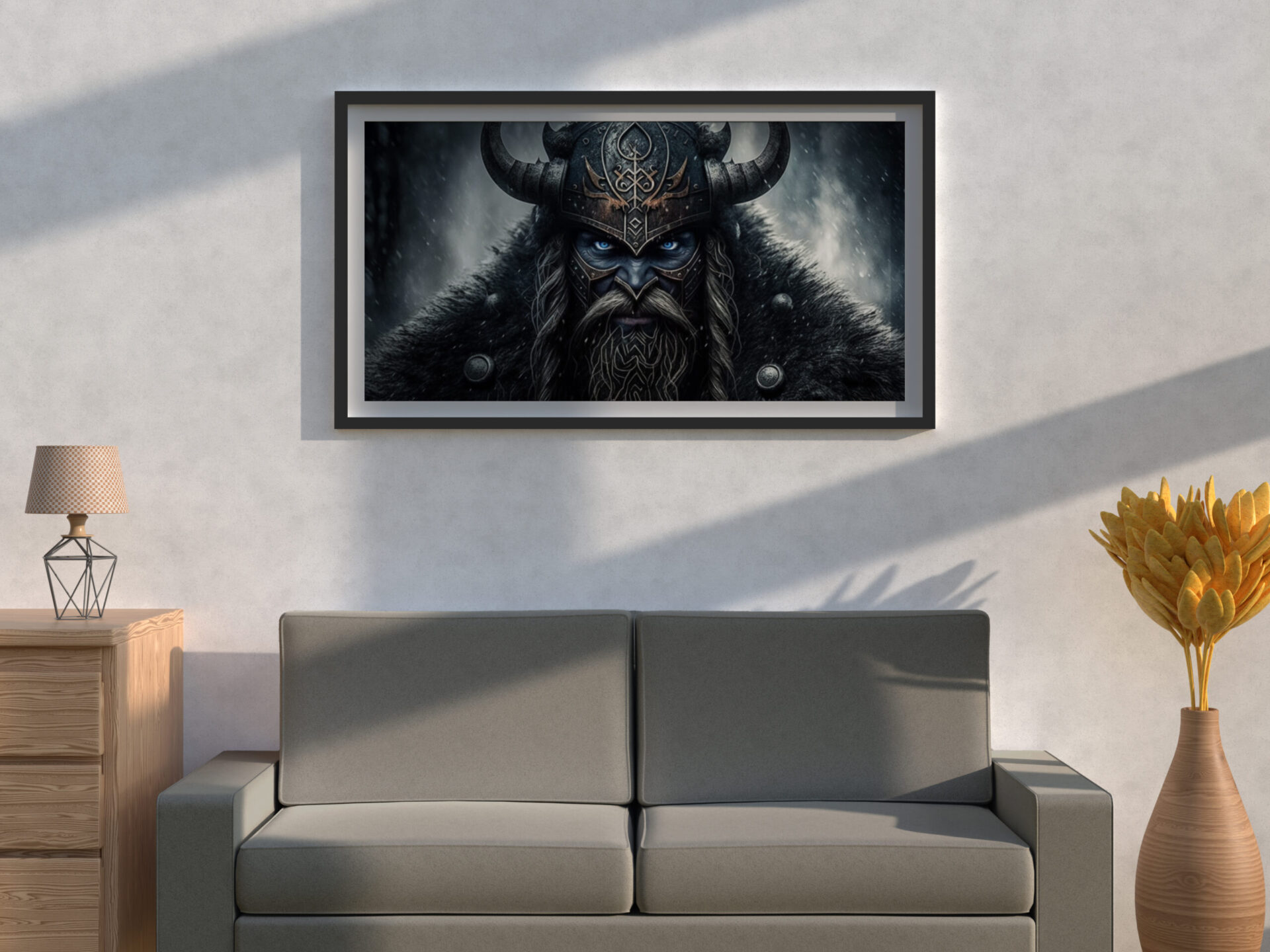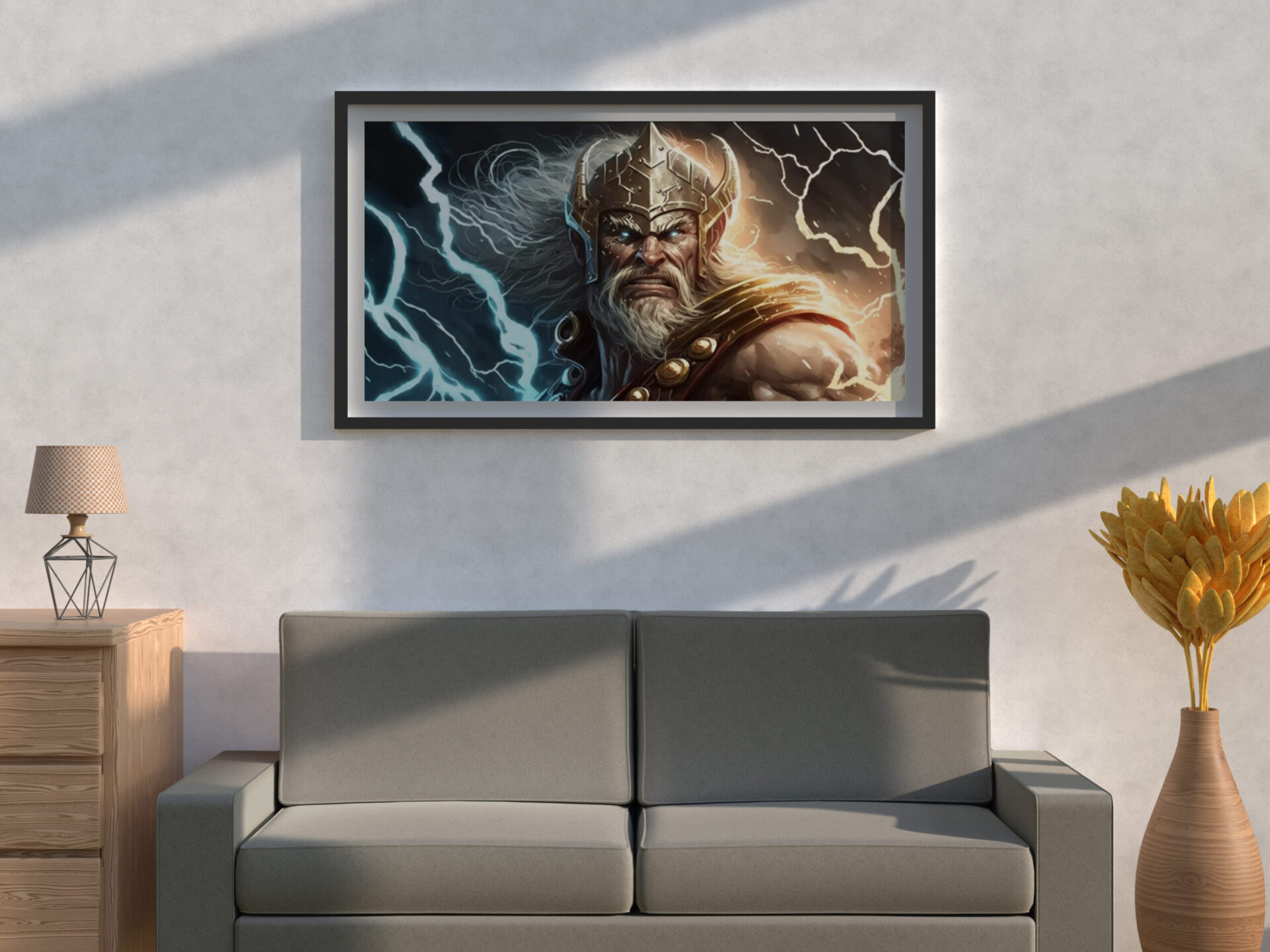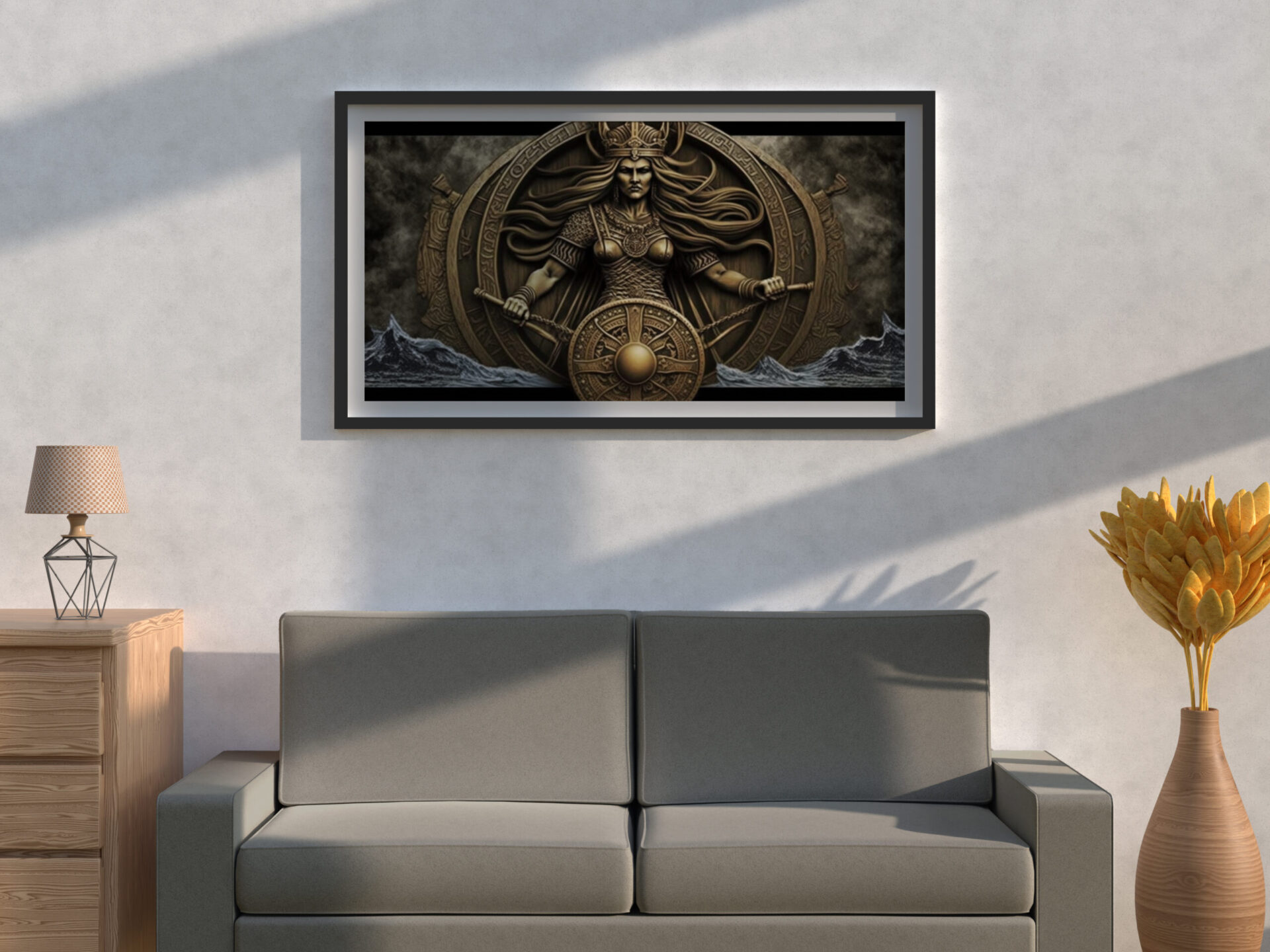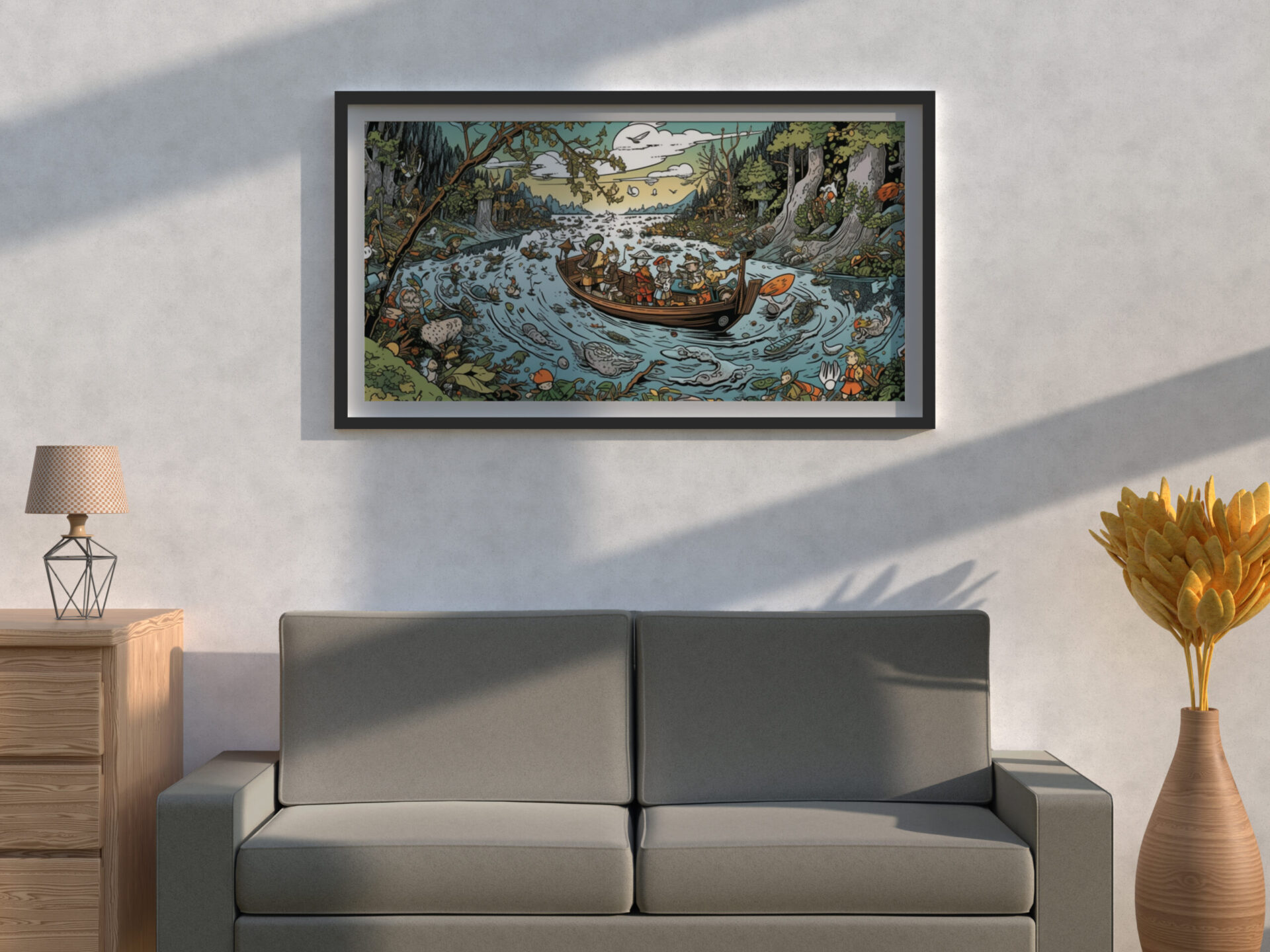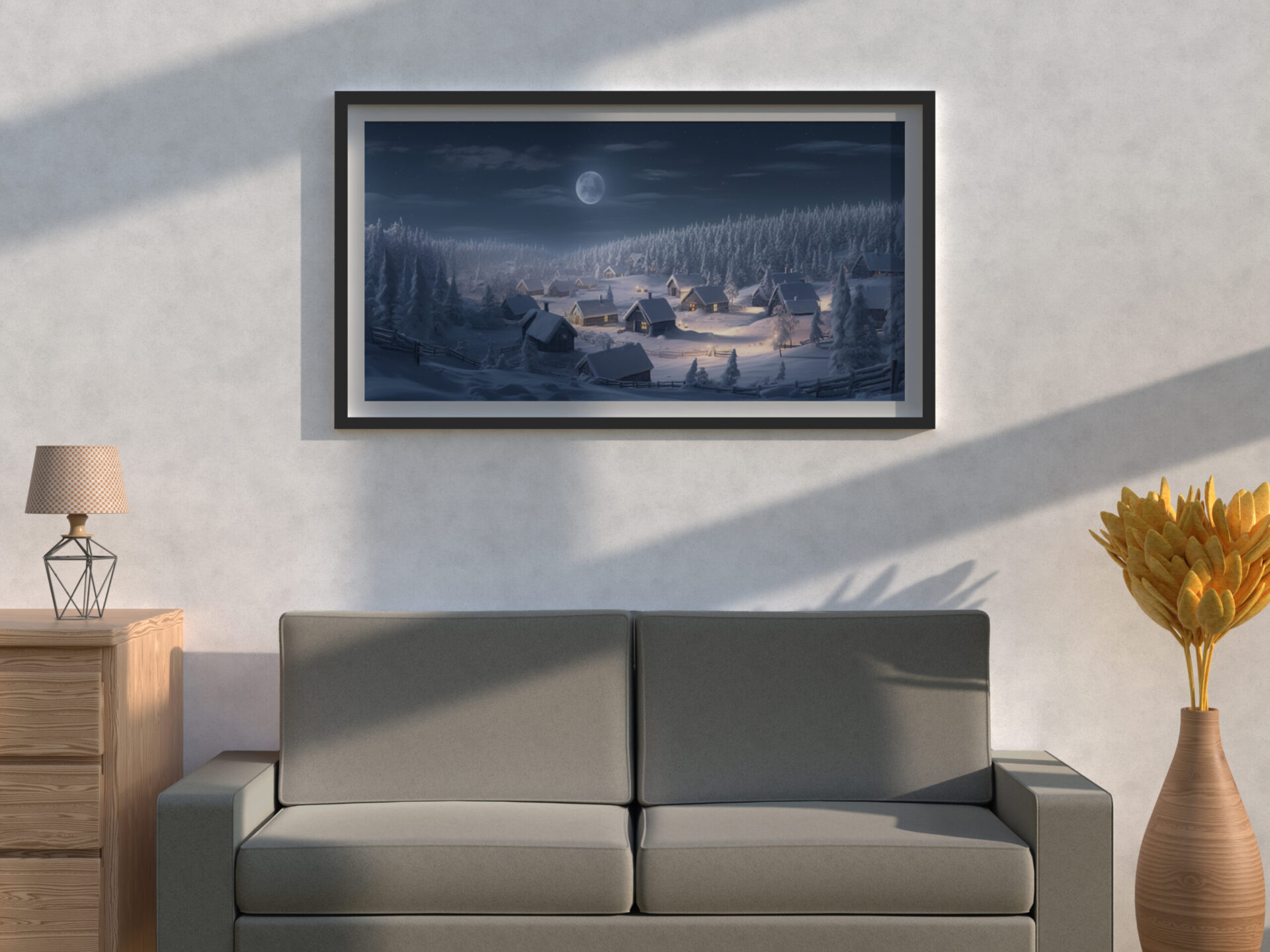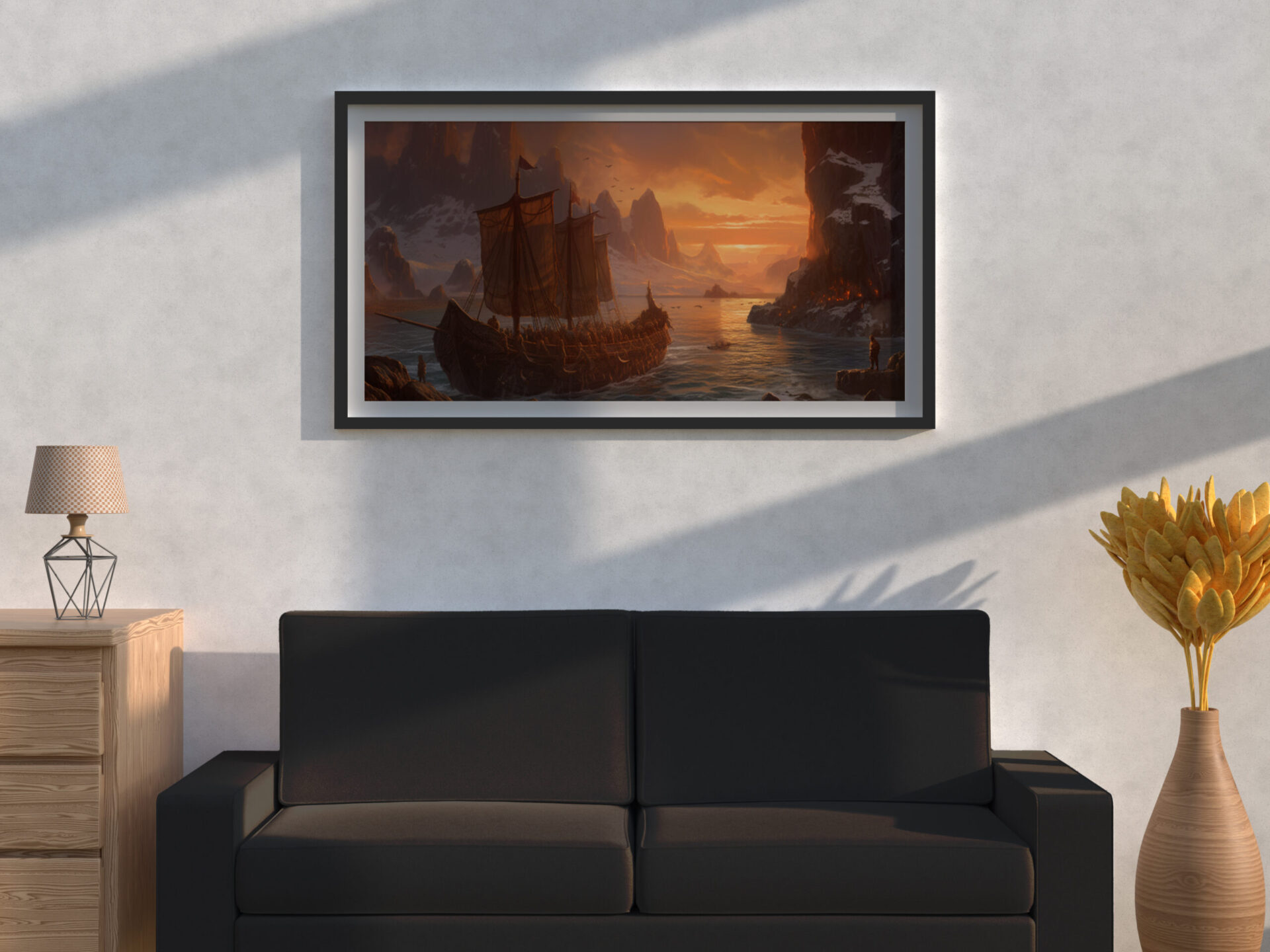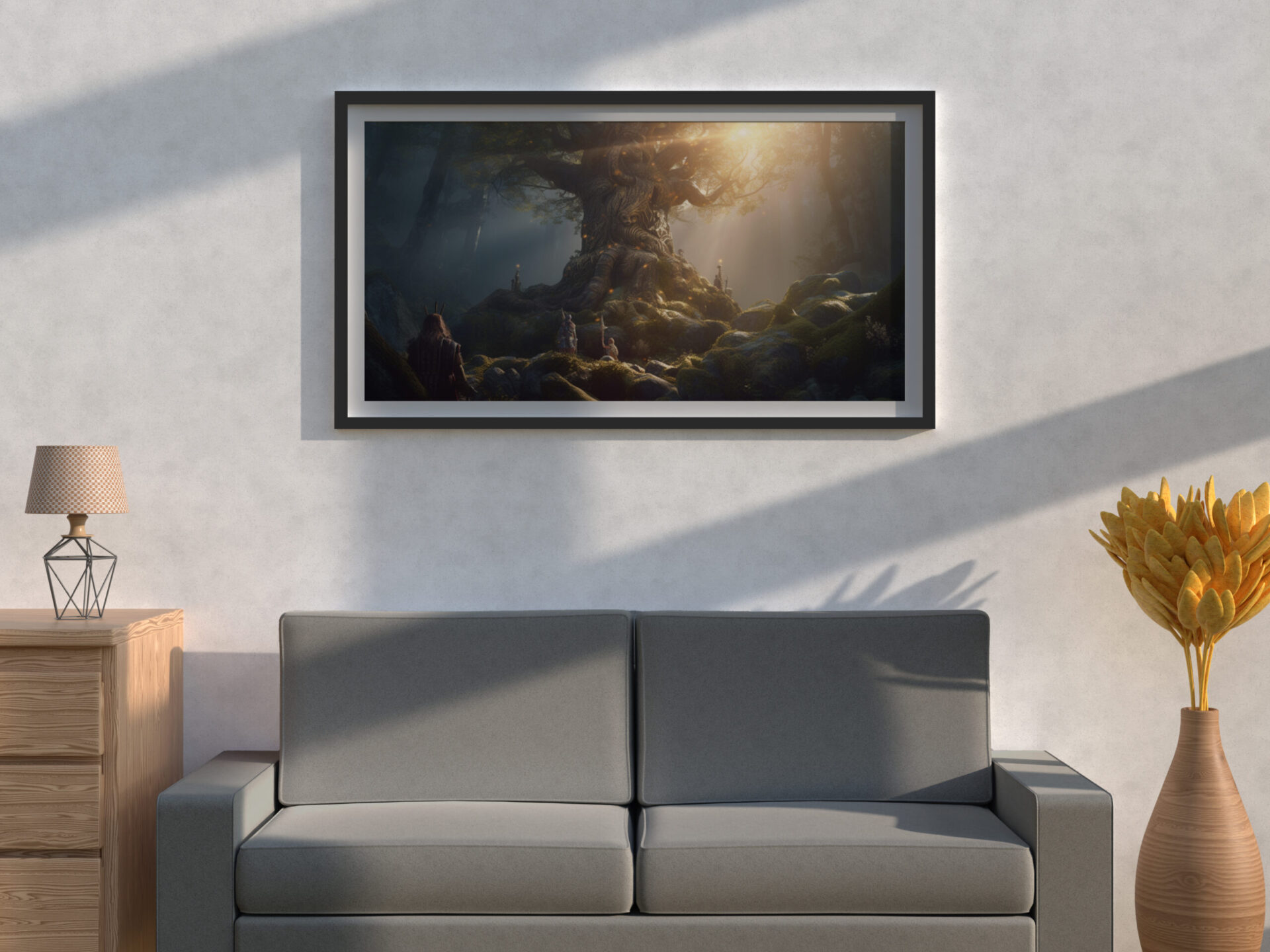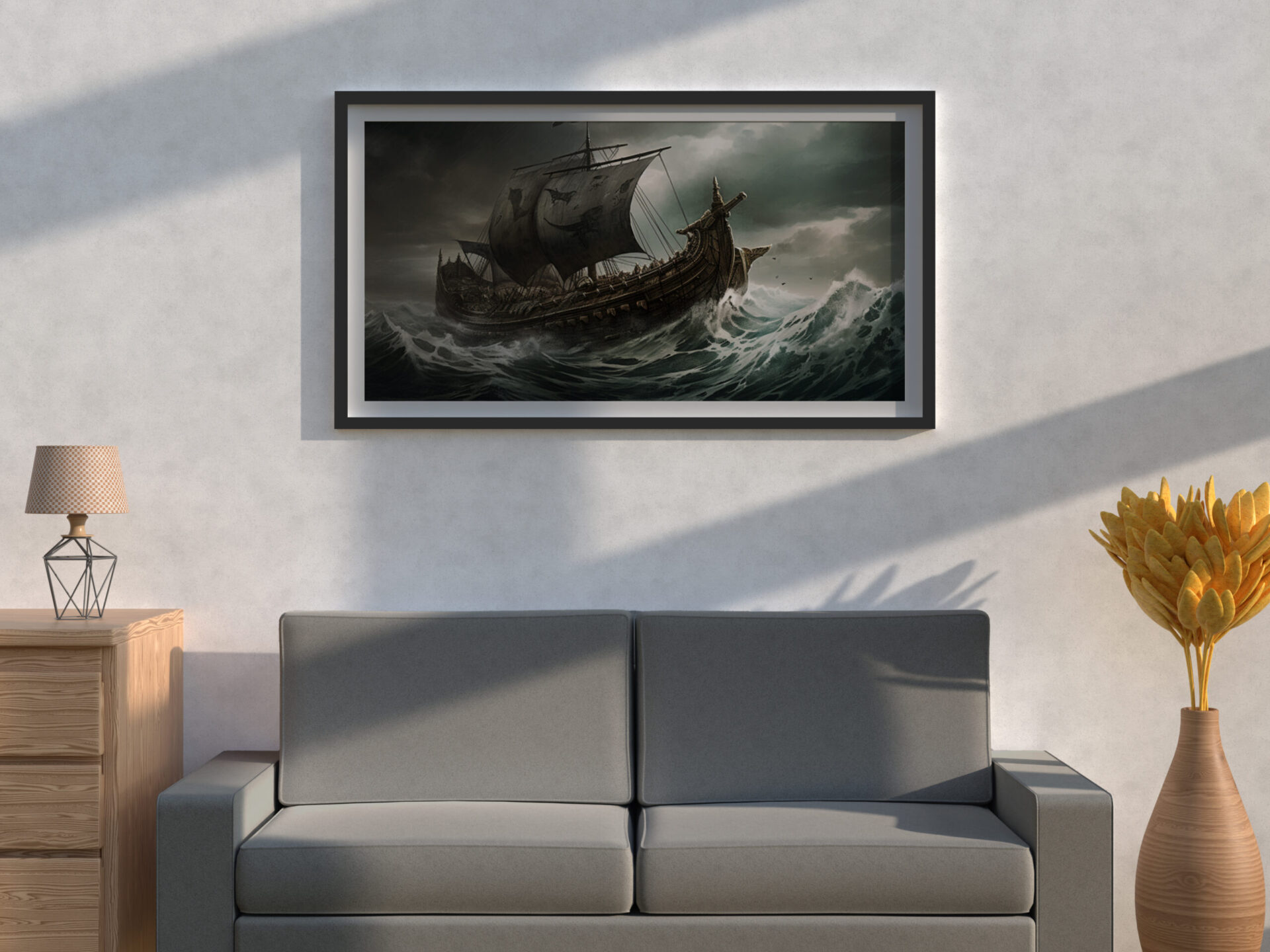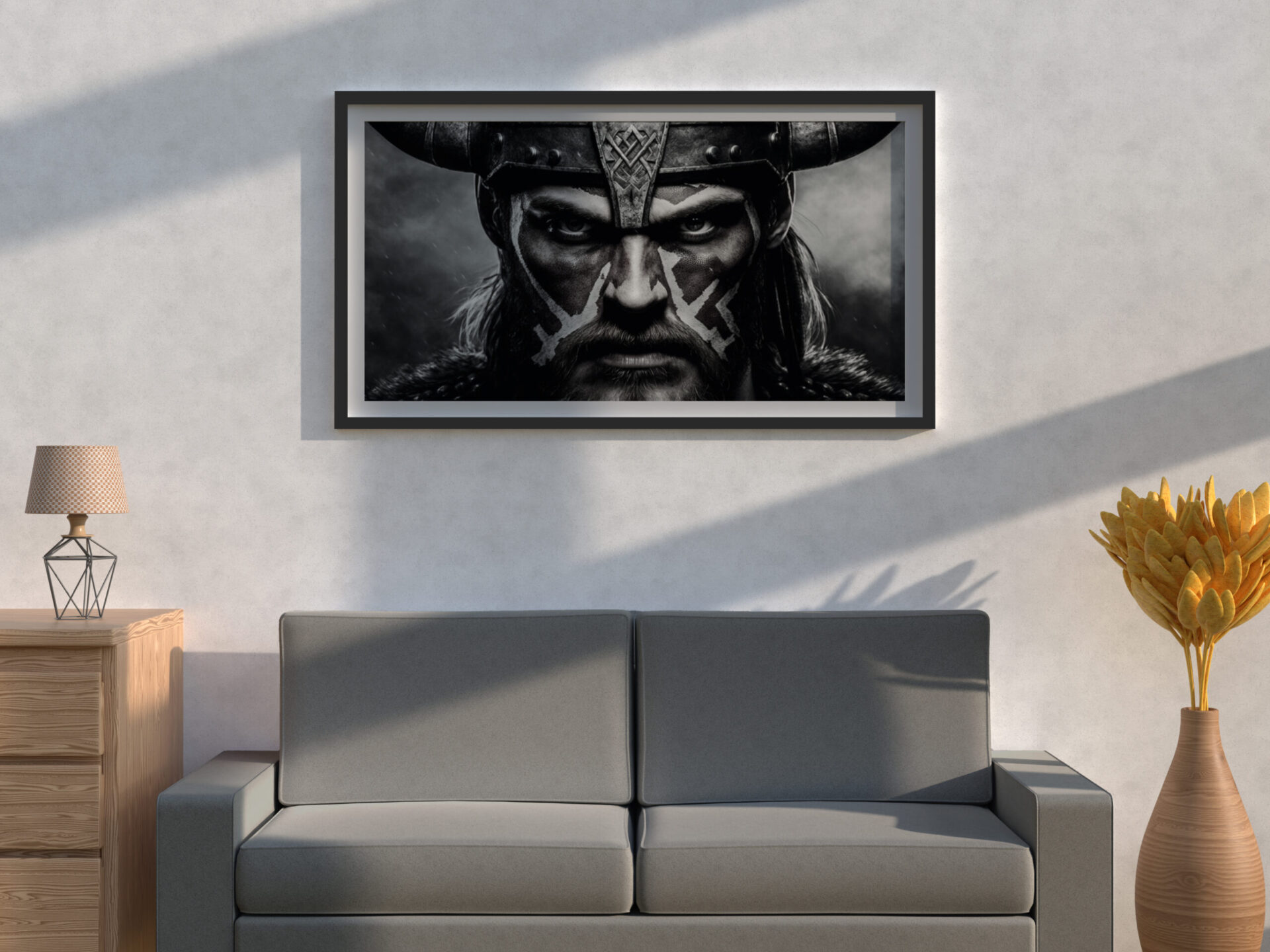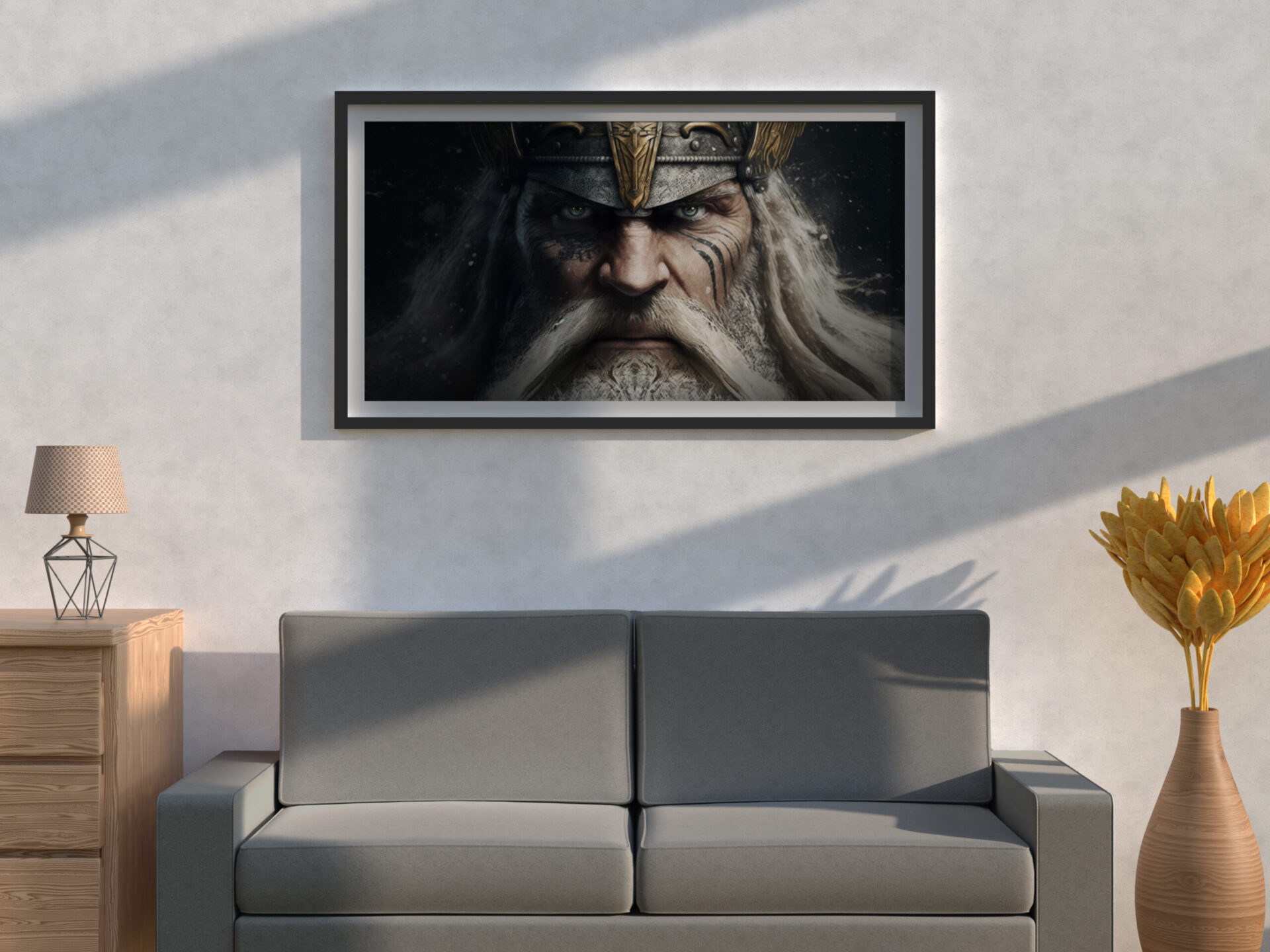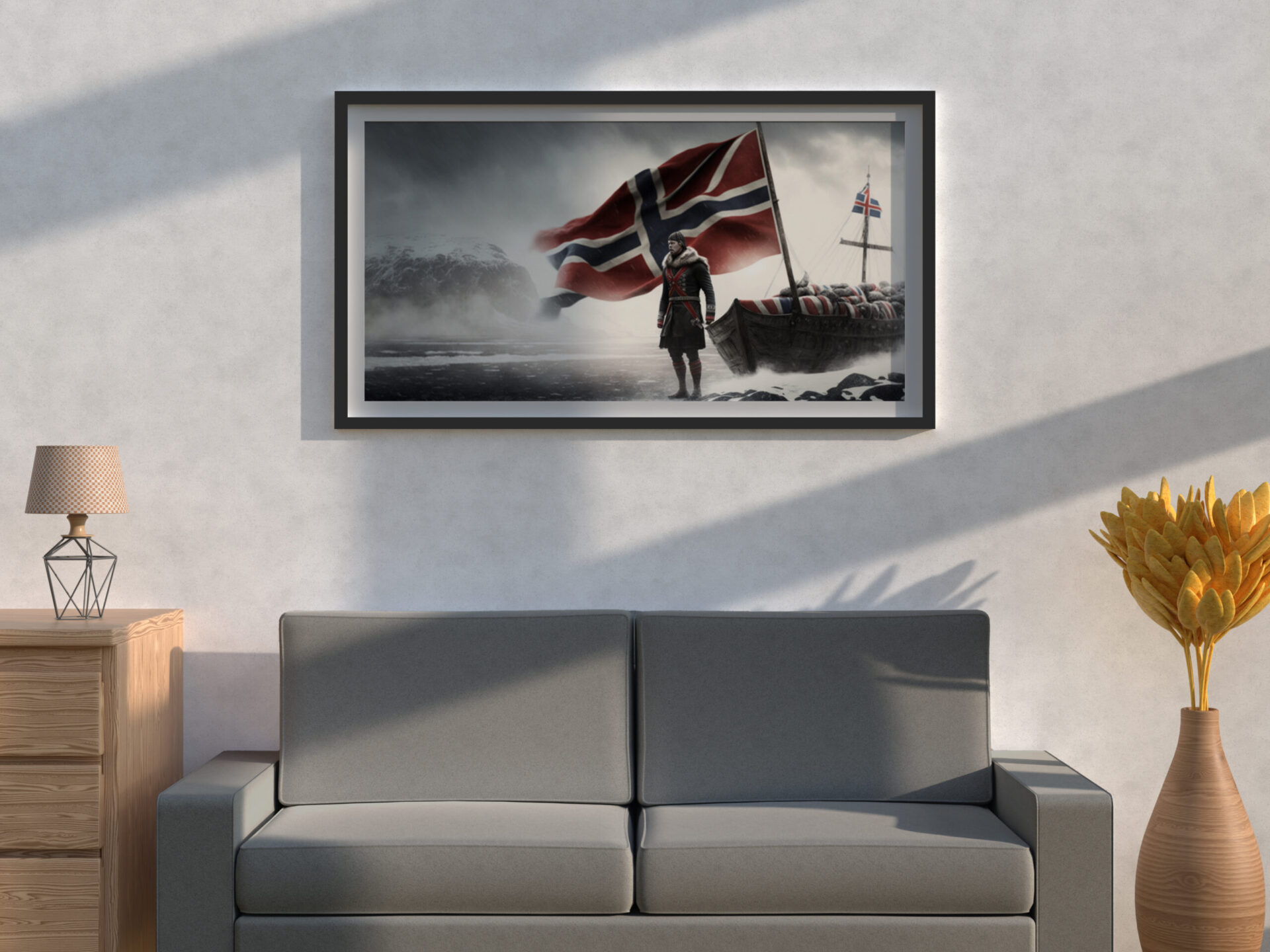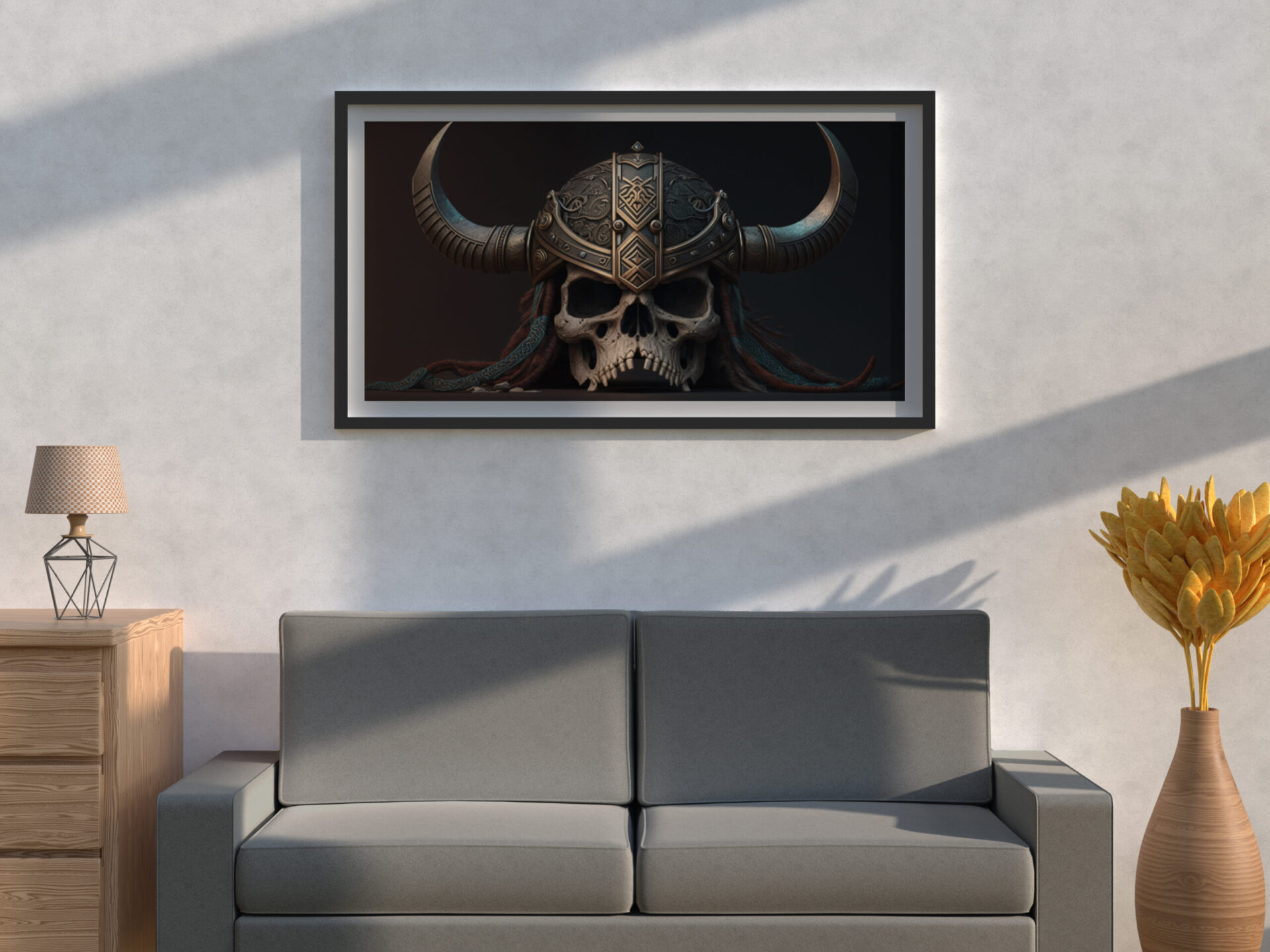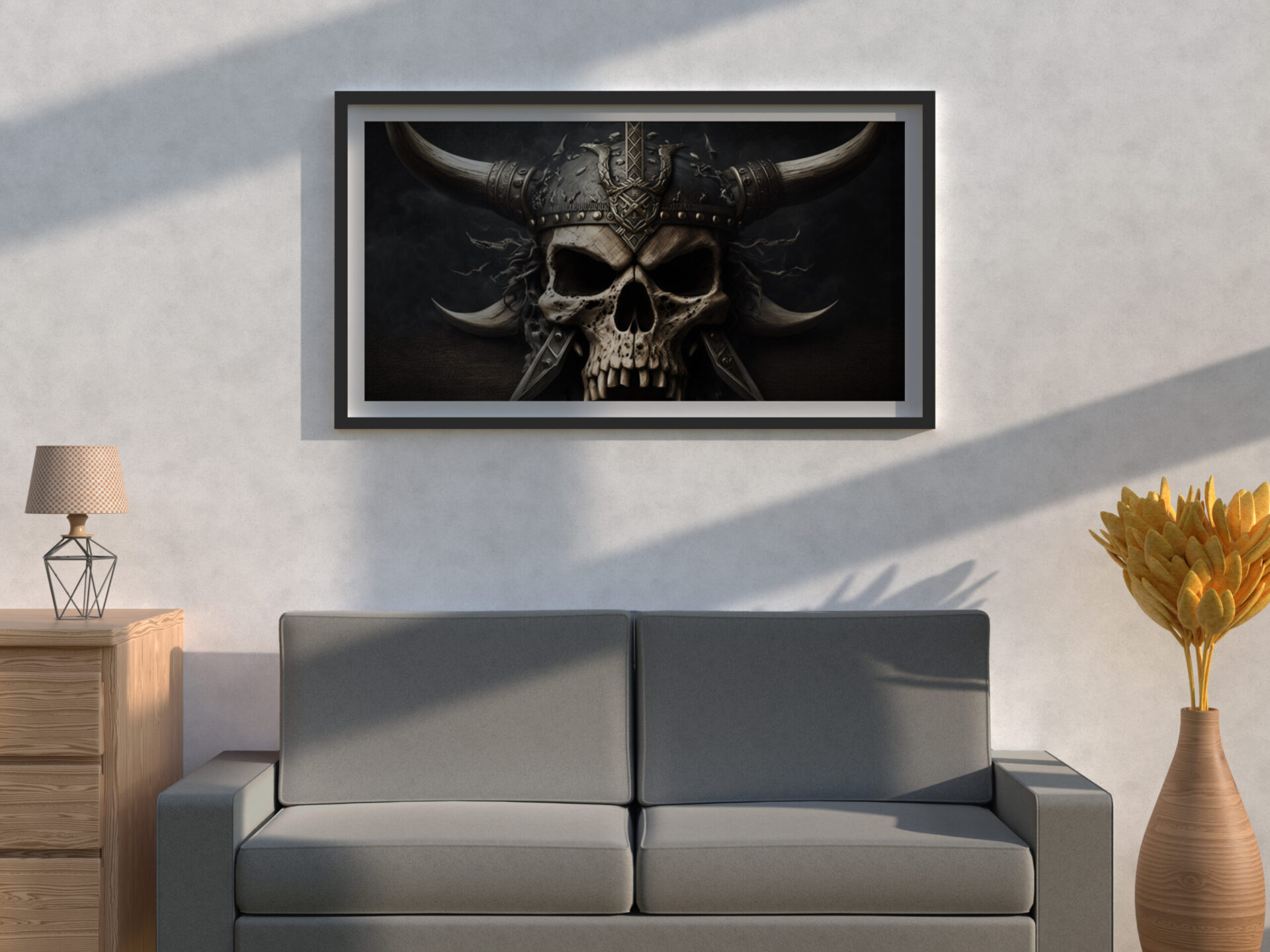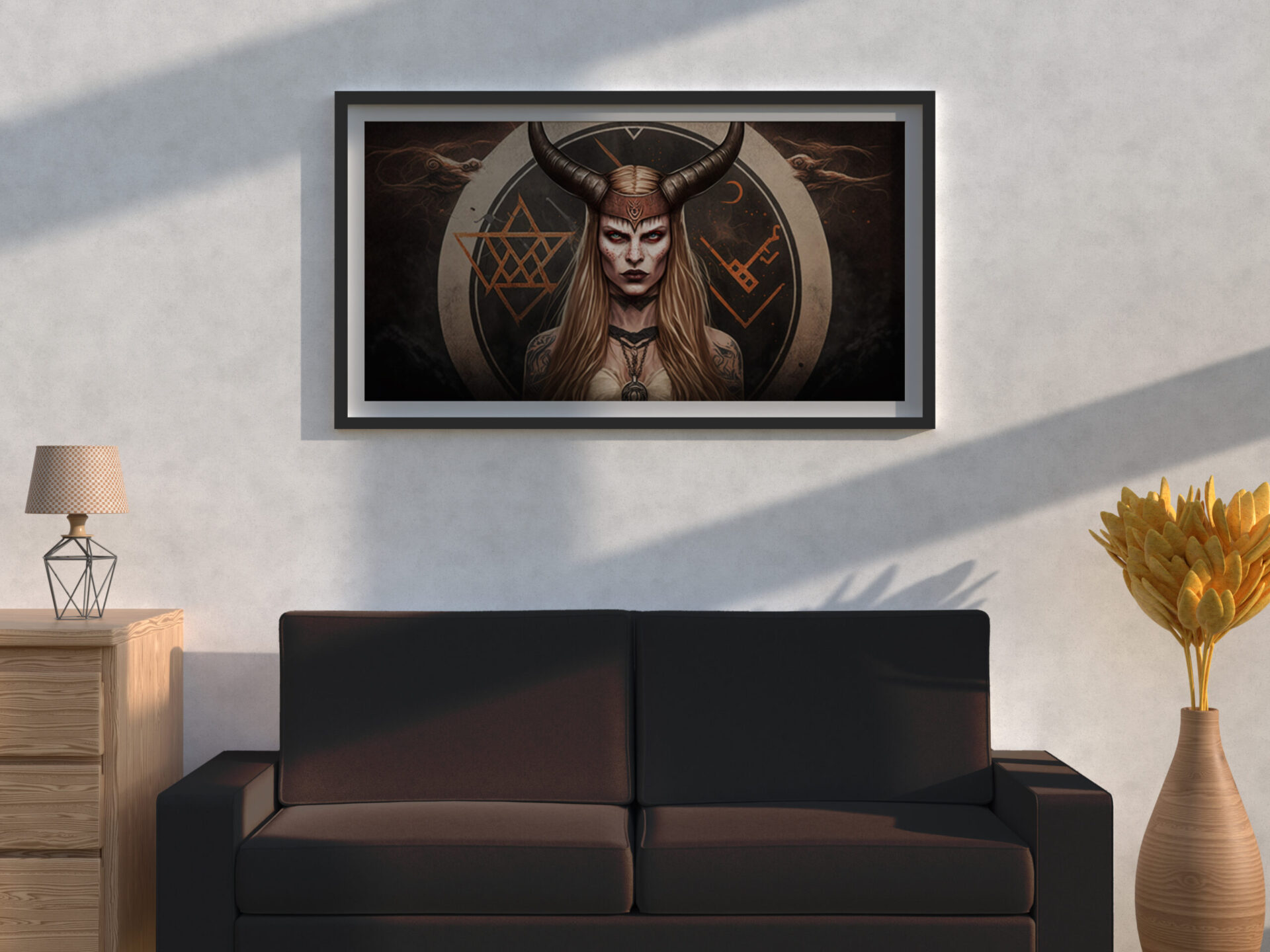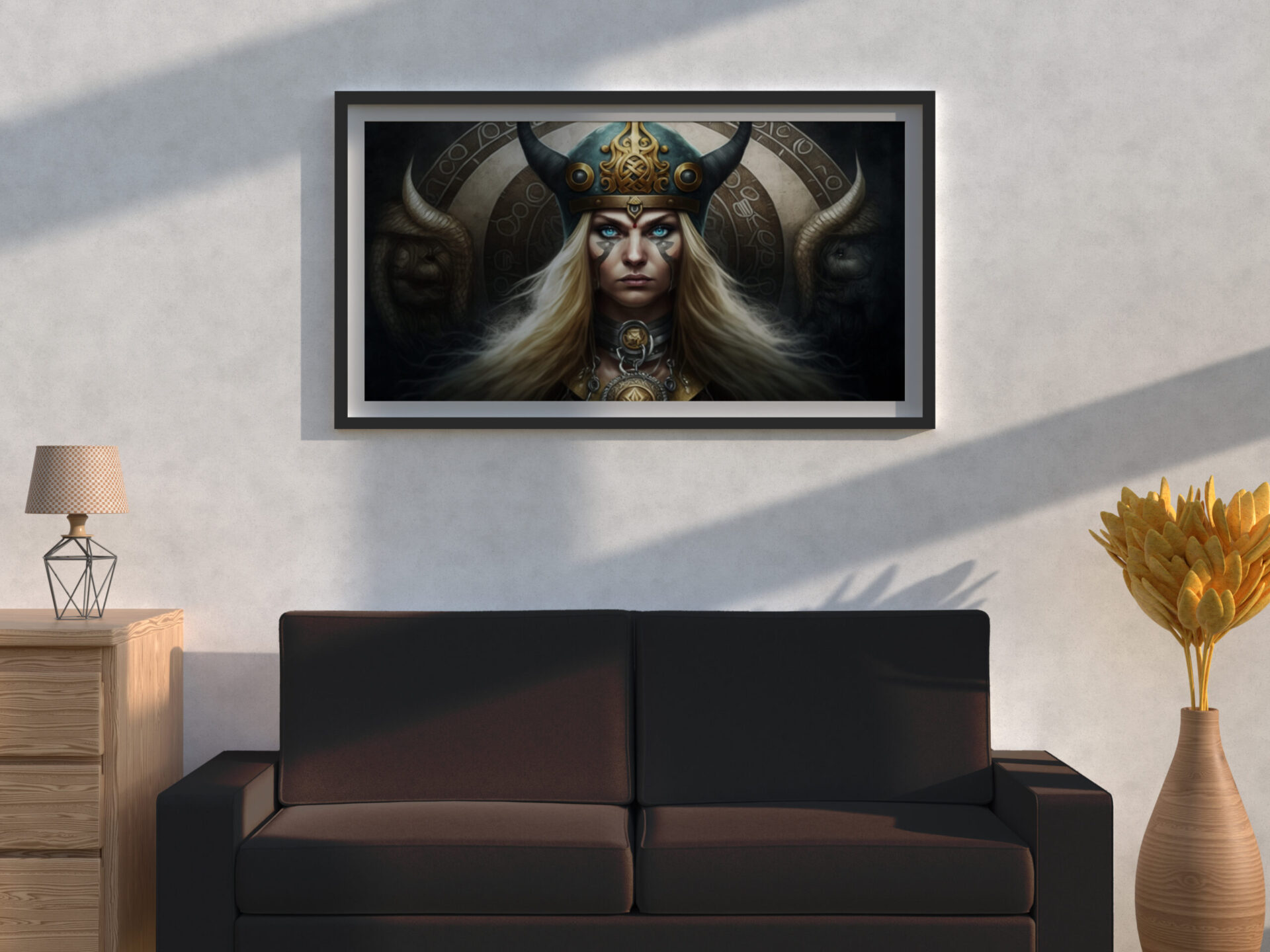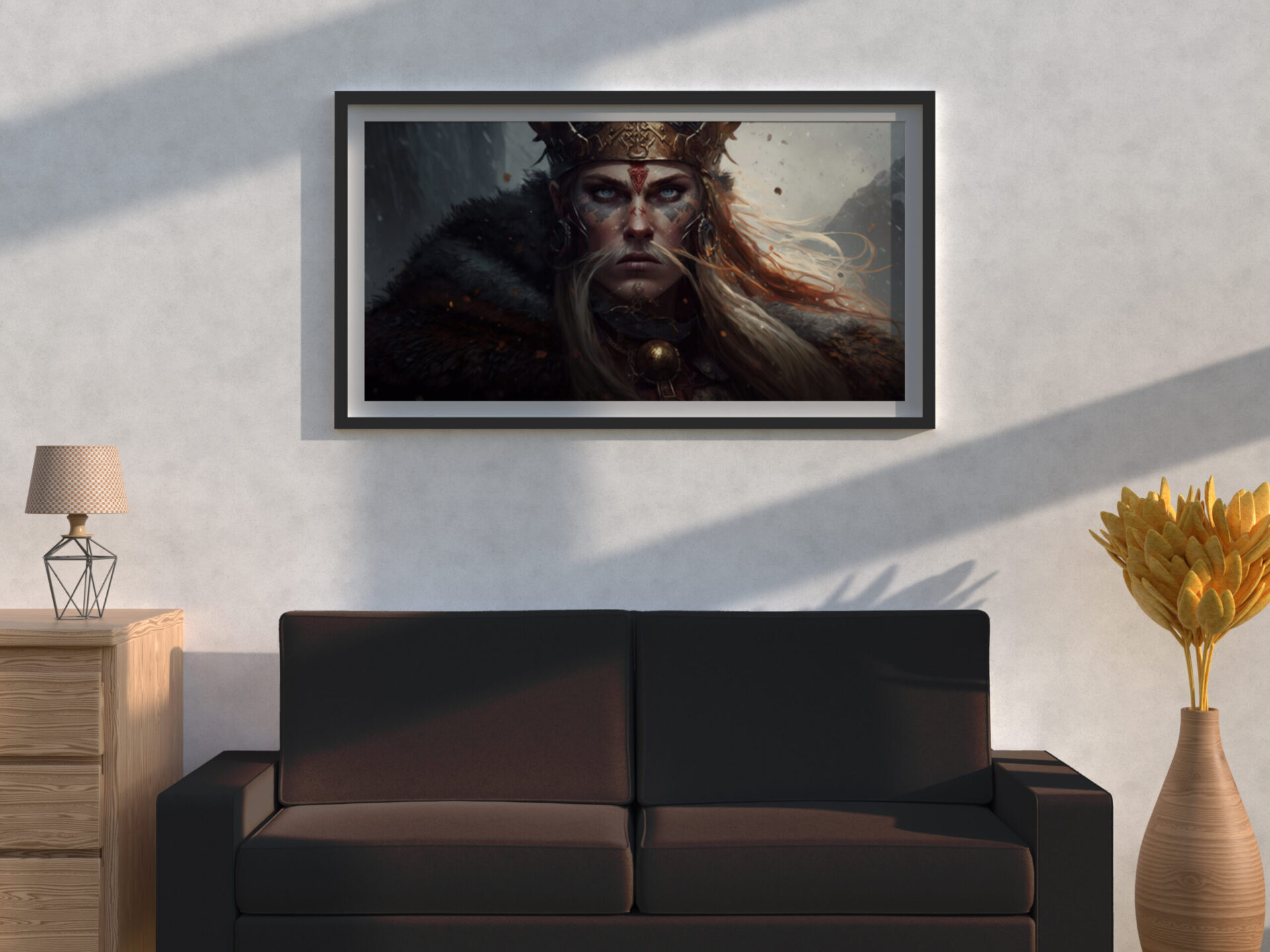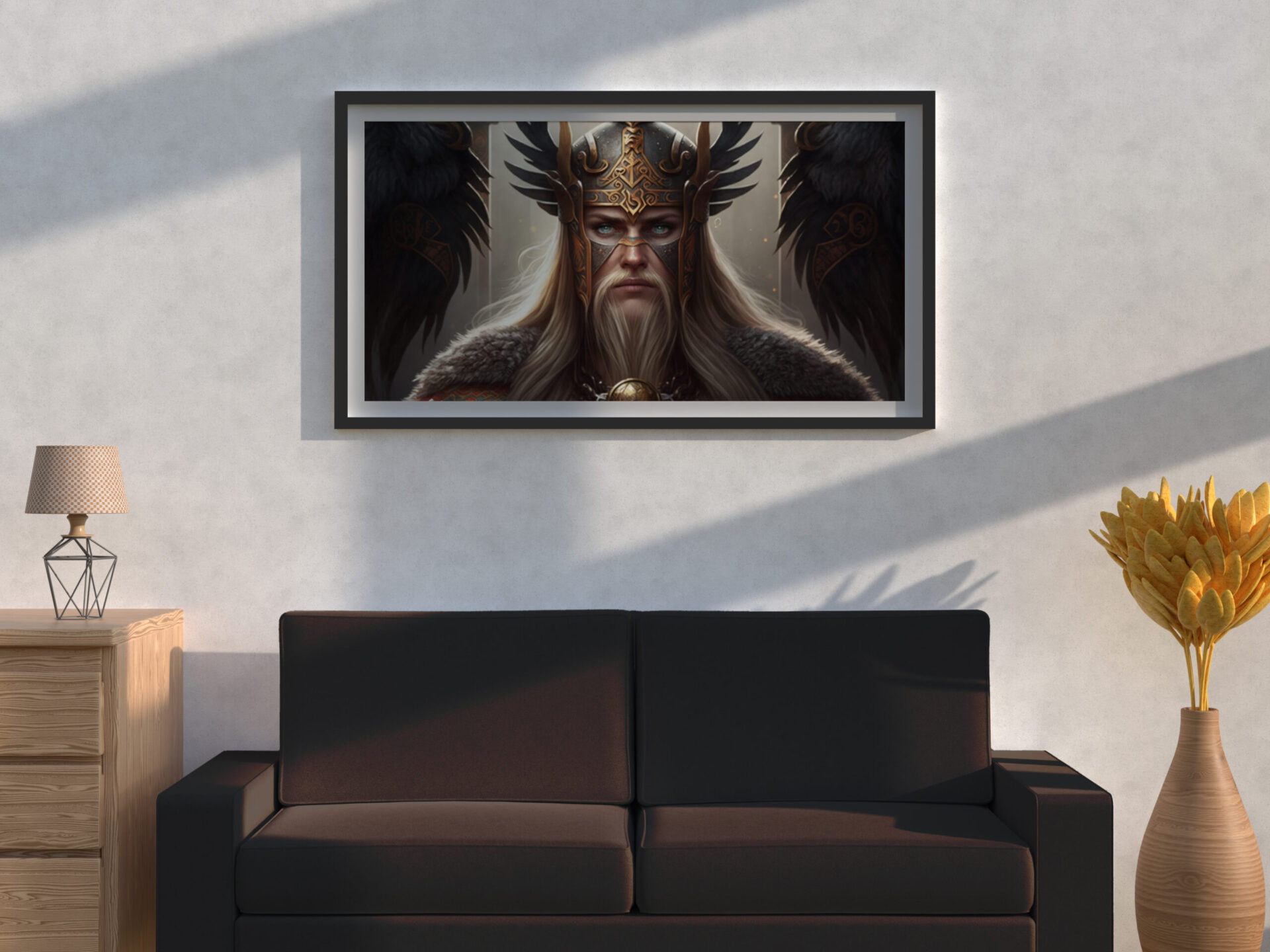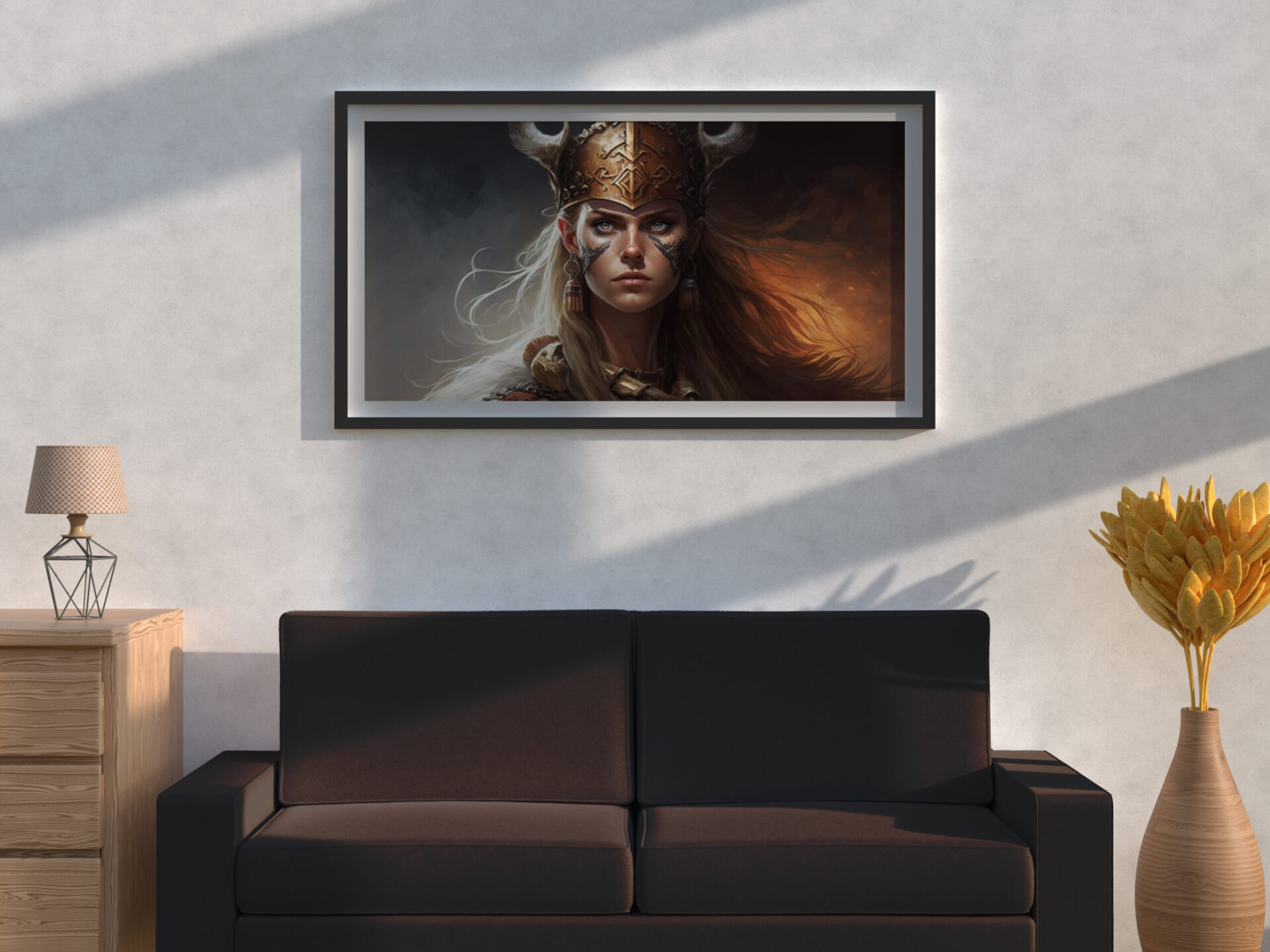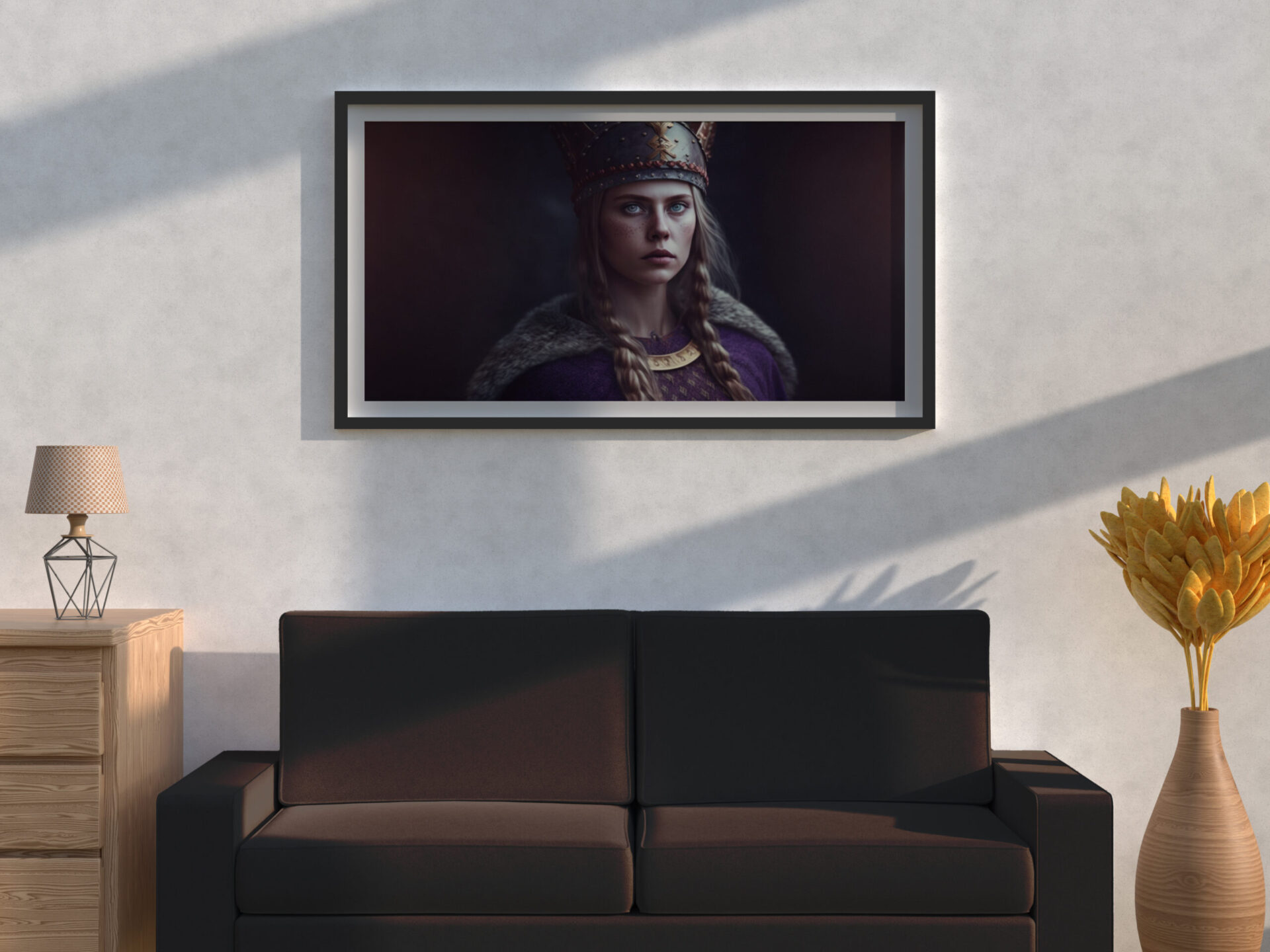Vikings wall art
Vikings wall art Iðunn
Vikings wall art Nordic sea
Vikings wall art Viking Raid
Vikings wall art Sköll
Vikings wall art Fenrir
Vikings wall art Hel
Vikings wall art Sif
Vikings wall art Astrid
Vikings wall art Nordic God
Vikings wall art Skadi
Vikings wall art Lagertha
Vikings wall art Frigg
Vikings wall art Freyja
Welcome to the fascinating world of Vikings Wall Art. This unique form of home decor combines history, artistry, and a touch of Norse mystery, transforming any space into a reflection of the legendary Viking era.
The Rich History of Viking Art

The history of Viking art is as rich and complex as the culture from which it sprang. Originating in Scandinavia during the late 8th century, this art form accompanied the seafaring Norsemen on their expansive voyages across Europe and beyond. Viking art is not only a reflection of their daily life but also a vivid representation of their beliefs, myths, and social structure.
Key Characteristics of Viking Art
Viking art is distinguishable by its unique stylistic elements, often characterized by:
- Animalistic motifs: Intricate depictions of animals, both real and mythological, are a hallmark of Viking art. These designs often feature serpentine creatures and beasts from Norse mythology, interwoven in complex patterns.
- Geometric patterns: Viking artists frequently used geometric designs, which included interlacing patterns, knotworks, and spiral motifs.
- Symbolic Imagery: Many Viking artworks are rich in symbolism, representing various aspects of Norse mythology and belief systems. For instance, the hammer of Thor, Mjölnir, is a recurring symbol in Viking art, signifying strength and protection.
Evolution of Viking Art Styles
Over time, Viking art evolved through several distinct styles:
- Oseberg Style (late 8th to early 9th century): Characterized by gripping beasts and intricate animal designs.
- Borre Style (mid 9th to late 10th century): Recognizable by its ring chains and animal patterns.
- Jelling Style (late 9th to early 11th century): Marked by its animal figures intertwined with ribbons.
- Mammen Style (late 10th century): Known for its detailed and elegant animal figures.
- Ringerike Style (early 11th century): Featured more elaborate and intertwined animal and plant motifs.
- Urnes Style (mid 11th century): The last phase, distinguished by its slim and stylized animal figures.
Viking Artifacts and Their Cultural Significance
Viking art is found in various forms, from jewelry and weaponry to stone carvings and ship designs. Each piece tells a story, giving insights into the Viking way of life, their beliefs, and their artistic prowess. Notable artifacts include:
- Runestones: Engraved stones with runic inscriptions, often serving as memorials or markers.
- Sculptures: Figurines and carvings made from materials like wood and bone, depicting gods, animals, and scenes from Norse mythology.
- Viking Ships: The intricate carvings on Viking ships are not only artistic achievements but also symbols of the Vikings’ seafaring dominance and technological advancements.
Through their art, Vikings left a lasting legacy that continues to fascinate and inspire. Their artistic expressions, deeply rooted in their culture and beliefs, offer a window into a world of warriors, explorers, and storytellers.
Styles and Themes in Viking Wall Art

Viking wall art encompasses a diverse array of styles and themes, each telling its own tale of Norse mythology, history, and lifestyle. The art forms range from traditional to contemporary, offering a wide spectrum for art enthusiasts and history buffs alike.
Traditional Viking Art
Traditional Viking art is deeply rooted in Norse mythology and culture. Key elements include:
- Mythological Depictions: Scenes from Norse myths, featuring gods like Odin and Thor, and mythical creatures such as dragons and serpents.
- Scenes of Daily Life and Battles: Illustrations of Viking daily life, including their famed sea voyages and legendary battles.
- Runic Inscriptions: Often accompany art pieces, adding historical context and authenticity.
Contemporary Viking Art
Contemporary Viking art blends ancient motifs with modern artistic expressions, creating pieces that resonate with today’s audience. This style includes:
- Modern Interpretations of Mythology: Reimagining Norse myths through a contemporary lens, often using abstract designs and vibrant colors.
- Mixed Media Artworks: Combining traditional elements like wood or metal with modern materials and techniques.
- Geometric and Minimalist Designs: Simplifying the intricate patterns of traditional Viking art into more geometric shapes and lines.
Popular Themes in Viking Art
- Norse Gods and Goddesses: Depicting the pantheon of Norse deities, each artwork tells a story of power, wisdom, or mischief.
- Viking Warriors and Heroes: Celebrating the bravery and exploits of Viking warriors, these pieces often depict scenes of battle and adventure.
- Nordic Landscapes and Seascapes: Capturing the serene beauty of the Scandinavian landscapes and the treacherous waters of the North Sea.
- Viking Ships and Maritime Life: Illustrating the importance of sea voyages in Viking life, these artworks showcase the intricate design of Viking longships.
- Animal Motifs and Symbolism: Incorporating animals like ravens, wolves, and serpents, which held significant meaning in Viking mythology.
The Role of Viking Art in Modern Decor
Viking art plays a vital role in modern decor by adding an element of historic intrigue and artistic depth. Whether it’s a canvas wall art depicting a Norse saga or a metal wall sculpture with Viking runes, these pieces bring a unique aesthetic to any space.
Incorporating Viking Art in Various Settings
- Home Decor: Adds a touch of historical elegance to living rooms, entryways, or bedrooms.
- Office Spaces: Viking art can be a conversation starter, lending an air of sophistication and cultural richness.
- Public Venues: In spaces like museums or galleries, Viking art serves as an educational and aesthetic element.
Viking wall art, with its rich variety of styles and themes, offers endless possibilities to explore and incorporate into modern living spaces. Its ability to connect the past with the present makes it a timeless addition to any art collection.
Viking Art Techniques and Materials
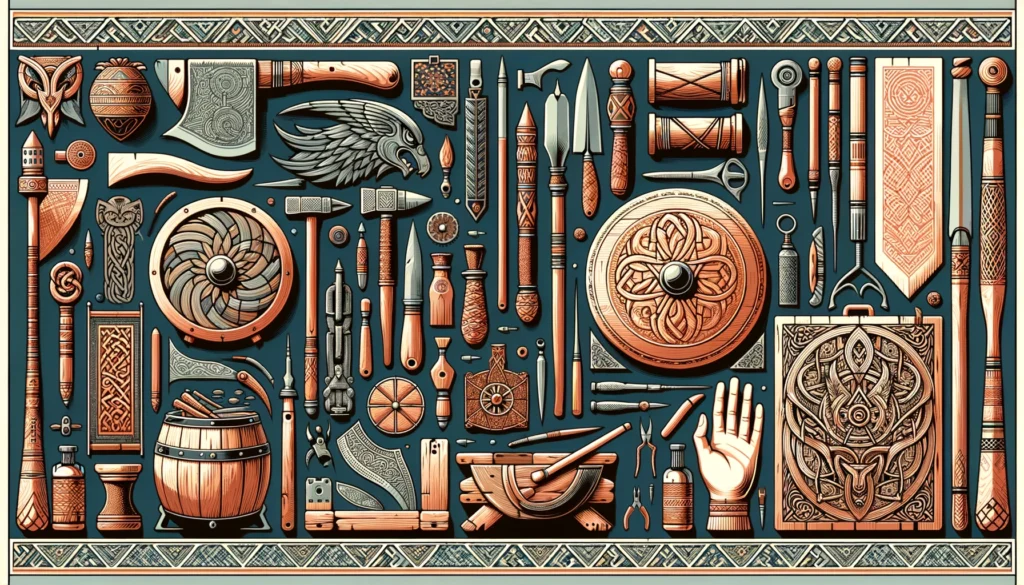
Viking art, renowned for its intricate designs and skilled craftsmanship, utilized a variety of techniques and materials. Understanding these methods not only gives insight into the artistry of the Vikings but also helps in appreciating the cultural significance of their work.
Traditional Techniques
Traditional Viking art techniques were deeply rooted in the materials and tools available during the Viking Age. These included:
- Wood Carving: Vikings were skilled woodworkers. They carved intricate designs, often depicting scenes from Norse mythology or geometric patterns, into various wooden objects including ships, tools, and household items.
- Metalwork: Metal was used for both functional and decorative purposes. Vikings created detailed jewelry, weaponry, and ceremonial items, often embellished with gold, silver, and precious stones.
Modern Techniques
Modern interpretations of Viking art utilize both traditional methods and contemporary techniques:
- Hand Painting: Artists today often use hand painting to recreate traditional Viking designs or to give a modern twist to historical themes.
- Digital Art: The use of digital tools has allowed for the creation of Viking art that retains traditional elements while incorporating modern aesthetics.
Materials Used in Viking Art
Viking art is characterized by the use of both organic and inorganic materials:
| Material | Use in Viking Art |
|---|---|
| Wood | Used for carvings, sculptures, and shipbuilding. |
| Metal | For creating jewelry, weapons, and other artifacts. |
| Bone & Ivory | Utilized in smaller, intricate carvings. |
| Textiles | Embroidered with traditional Viking patterns. |
Preservation Techniques
The preservation of Viking art is crucial for historical and cultural conservation. This involves:
- Restoration: Skilled conservators work to restore and preserve ancient Viking artifacts using modern techniques while maintaining their historical integrity.
- Replication: Artists and craftsmen create replicas of Viking art, allowing for broader public access and appreciation.
Contemporary Materials in Viking Art
Contemporary artists creating Viking-themed art often use a mix of traditional and modern materials, such as:
- Canvas and Paints: For paintings and prints depicting Viking themes.
- Mixed Media: Combining materials like metal, wood, and synthetic elements to create unique pieces.
The Role of Artisans and Craftsmen
Artisans and craftsmen play a vital role in keeping the tradition of Viking art alive. Whether it’s through traditional woodworking or modern metalworking, these artists bridge the gap between the past and present.
Decorating with Viking Wall Art
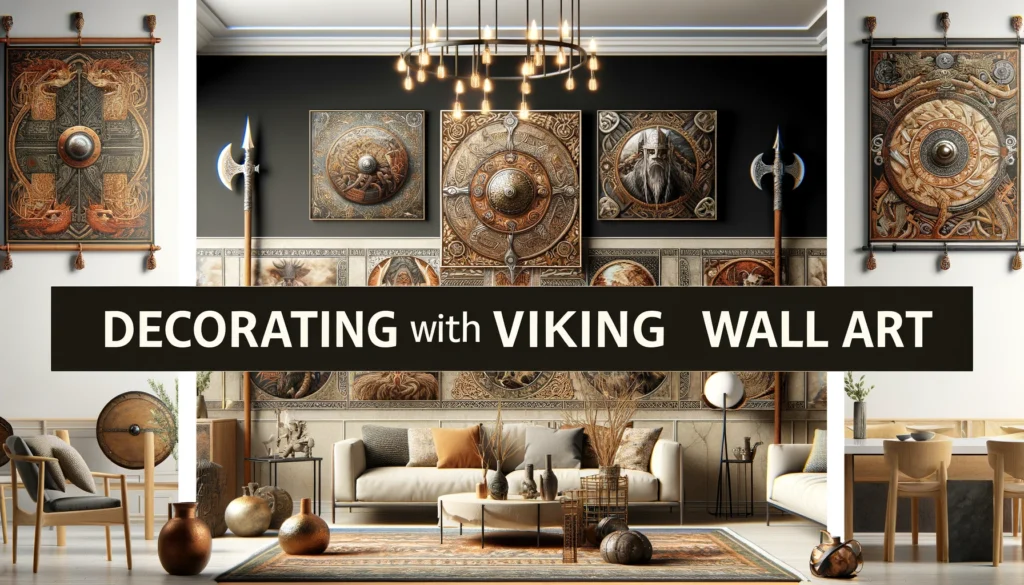
Incorporating Viking wall art into modern decor adds a touch of historical elegance and a unique character to any space. This type of art, with its bold motifs and rich symbolism, can complement a variety of interior design styles.
Choosing the Right Piece for Your Space
When selecting Viking wall art for your home, consider the following aspects:
- Color Scheme: Choose art that complements or accentuates the existing colors in your room.
- Size and Scale: Large pieces like canvas wall art or metal wall sculptures make a statement in spacious rooms, while smaller pieces like framed prints are ideal for more intimate spaces.
- Theme Consistency: Ensure that the art aligns with the overall theme and aesthetic of your space.
Placement Ideas
Strategic placement can maximize the impact of your Viking wall art. Some suggestions include:
- Living Room: A large canvas wall art or a metal wall sculpture can serve as a focal point.
- Bedroom: Smaller, more intricate pieces like framed wall art or tapestries can create a sense of tranquility.
- Office: Art pieces featuring Norse mythology or Viking landscapes can add an air of sophistication.
Combining Viking Art with Modern Elements
Blending Viking art with contemporary design elements can create a dynamic and harmonious look. For example:
- Gallery Walls: Mix and match different types of Viking art, like canvas prints, framed art, and metal pieces to create an eclectic gallery wall.
- Accent Pieces: Use Viking art as an accent alongside modern furniture and decor to create a balanced aesthetic.
Enhancing Different Interior Styles with Viking Art
Viking wall art can complement various interior design styles:
- Minimalist Spaces: Sleek and simple Viking designs can enhance the clean lines of a minimalist interior.
- Rustic Settings: Robust and earthy Viking motifs work well in rustic decor, adding a sense of warmth and history.
- Contemporary Rooms: Abstract or modern interpretations of Viking art can add intrigue to contemporary spaces.
Lighting and Visibility
Proper lighting is key to showcasing Viking wall art effectively:
- Spotlights: Highlight a statement piece with focused lighting.
- Ambient Lighting: Soft, indirect lighting can enhance the mood set by the artwork.
Tips for Integrating Viking Art in Decor
- Balance: Ensure that the art doesn’t overwhelm the space but rather complements it.
- Theme: Use Viking art to tell a story or to add a narrative element to your decor.
- Versatility: Remember that Viking art can be versatile, fitting into different rooms and decor styles.
Incorporating Viking wall art into your home decor not only pays homage to a rich cultural heritage but also adds a unique, artistic touch to your living space. With the right selection and placement, Viking art can transform an ordinary room into a remarkable and inspiring environment.
Viking Art in Contemporary Design
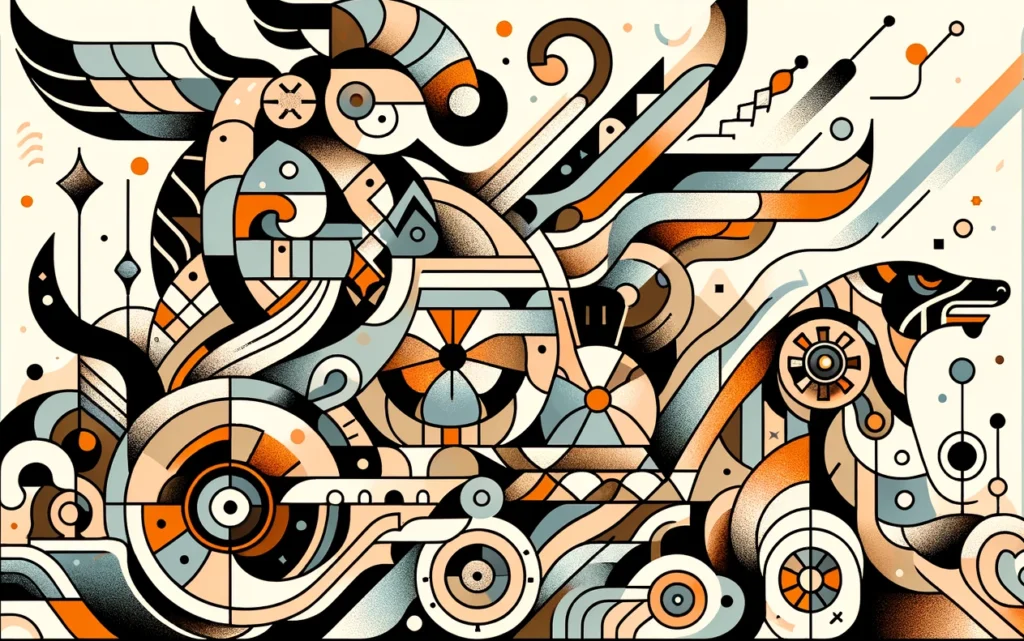
Viking art in contemporary design is a testament to the timeless appeal of Norse culture and aesthetics. Today’s artists and designers draw inspiration from Viking motifs, blending them with modern elements to create pieces that resonate with contemporary tastes while honoring historical legacy.
Modern Interpretations of Viking Themes
Contemporary Viking art often reinterprets traditional themes with a modern twist:
- Abstract Designs: Artists use abstract forms to depict Viking myths and legends, offering a fresh perspective on these ancient stories.
- Geometric Patterns: Modern Viking art sometimes incorporates geometric elements, aligning with the clean, minimalist trends in contemporary art and design.
Materials and Techniques in Contemporary Viking Art
Innovative materials and techniques are at the forefront of modern Viking art:
- Digital Art: The use of digital tools allows for the creation of Viking-themed art with unprecedented precision and versatility.
- Mixed Media: Combining traditional materials like wood and metal with modern elements like acrylics and digital prints, artists create multi-dimensional pieces.
Color Palettes in Contemporary Viking Art
Modern Viking art often features a diverse range of color palettes:
- Monochromatic Schemes: These bring a modern, sophisticated look to Viking motifs.
- Vibrant Colors: Bright, bold colors infuse traditional Viking designs with contemporary energy.
The Influence of Viking Art in Modern Interior Design
Viking art influences modern interior design in several ways:
- Wall Decor: Canvas prints, tapestries, and metal wall art with Viking themes are popular choices for adding character to contemporary spaces.
- Functional Art: Items like rugs, throws, and cushions featuring Viking designs combine aesthetics with utility.
Fusion of Old and New in Art
The fusion of old and new in Viking art creates unique pieces:
- Traditional Meets Modern: Artists merge classic Viking imagery with modern artistic expressions, bridging historical art with current trends.
- Cultural Synthesis: This fusion reflects a cultural synthesis, appealing to both admirers of Norse history and lovers of contemporary art.
The Role of Viking Art in Modern Culture
Viking art plays a significant role in modern culture by:
- Preserving History: Keeping the Viking legacy alive through artistic expression.
- Inspiring Creativity: Serving as a source of inspiration for artists and designers globally.
The Process of Creating Viking Art

The process of creating Viking art is a fascinating blend of historical techniques and modern creativity. This journey from concept to finished piece is both an art and a craft, requiring skill, patience, and a deep understanding of Viking culture.
Conceptualization and Design
The first step in creating Viking art involves:
- Research and Inspiration: Artists often start by researching Viking history, mythology, and traditional art forms to gather inspiration.
- Sketching and Designing: Preliminary sketches are made, often using traditional motifs like Norse runes, mythological creatures, and legendary figures.
Choosing the Right Materials
Selecting materials is crucial in the art-making process:
- Traditional Materials: Wood, metal, and textiles are commonly used, staying true to Viking era methods.
- Modern Alternatives: Contemporary artists might also use materials like acrylics, digital mediums, and mixed media.
Crafting Techniques
Different techniques are employed depending on the medium:
- Carving and Sculpting: In wood or metal works, intricate carving and sculpting are fundamental.
- Painting and Illustrating: For canvas or paper-based artworks, various painting and illustrating techniques are used to bring the Viking themes to life.
Attention to Detail
Detailing is a critical aspect of Viking art:
- Intricacy: Fine details are often incorporated to represent the complexity of Norse mythology and Viking history.
- Authenticity: Maintaining historical accuracy is essential, especially when depicting specific myths or historical events.
Finishing and Preservation
The final steps ensure the artwork’s longevity and appeal:
- Sealing and Finishing: Applying finishes to protect the artwork and enhance its appearance.
- Framing and Mounting: For paintings and prints, proper framing and mounting are important for both presentation and preservation.
The Role of the Artist
Artists creating Viking art play a crucial role:
- Cultural Ambassador: They act as stewards of Norse heritage, bringing ancient stories and traditions to a modern audience.
- Innovator: Artists often innovate within the traditional boundaries of Viking art, introducing new styles and interpretations.
Challenges and Rewards
Creating Viking art comes with its challenges and rewards:
- Technical Skill: Mastering the traditional techniques requires significant skill and practice.
- Creative Satisfaction: Bringing a piece of history to life through art provides immense creative satisfaction.
The creation of Viking art is a meticulous and thoughtful process, deeply connected to Norse culture. It is a journey that honors the past while embracing the present, resulting in artworks that are both historically significant and visually stunning.
Viking Art as a Collector’s Item

Viking art holds a special place in the world of collectibles. Its historical significance, craftsmanship, and unique aesthetic make it a coveted item for collectors and enthusiasts alike.
Types of Collectible Viking Art
The range of collectible Viking art includes:
- Sculptures: Carved figures of Norse gods, warriors, and mythological creatures.
- Jewelry: Intricately crafted pieces often featuring symbols like Thor’s hammer.
- Runestones: Stones with runic inscriptions, significant for their historical and linguistic value.
- Metalwork: Includes finely detailed weaponry, amulets, and everyday items.
The Value of Viking Art
The value of Viking art is determined by several factors:
- Authenticity: Original pieces from the Viking era are highly valued for their historical authenticity.
- Craftsmanship: The skill and detail in the artwork play a crucial role in determining its value.
- Condition: Well-preserved pieces are more valuable than those with significant damage or wear.
- Provenance: The history of the piece, including its origin and previous ownership, adds to its value.
Acquiring Viking Art
For those interested in acquiring Viking art:
- Auctions: A common venue for finding authentic Viking art pieces.
- Antique Stores and Dealers: Specialized dealers can provide valuable pieces with verified authenticity.
- Online Marketplaces: Websites and online forums dedicated to historical artifacts offer another platform for acquisition.
Considerations for Collectors
Collectors should keep in mind:
- Verification: Ensure the authenticity of the piece through expert verification.
- Legal Aspects: Be aware of the legalities involved in owning and trading historical artifacts.
- Preservation: Proper care and preservation are essential to maintain the condition and value of the art.
Building a Collection
Tips for building a Viking art collection:
- Focus: Decide whether to focus on a specific type of art or a broader range.
- Research: Learn about the art form, its history, and the specifics of what makes a piece valuable.
- Networking: Connect with other collectors and experts for advice and opportunities.
The Joy of Collecting
Collecting Viking art is not just about possession but also about:
- Cultural Connection: Owning a piece of Viking art is a way to connect with Norse history and culture.
- Educational Value: Each piece offers a lesson in history, artistry, and ancient craftsmanship.
Viking art as a collector’s item presents a unique opportunity to own a piece of history. It is a passion that goes beyond mere aesthetics, offering a tangible link to the fascinating world of the Vikings.
Caring for and Preserving Viking Wall Art

Proper care and preservation are crucial for maintaining the beauty and integrity of Viking wall art. Whether it’s an ancient artifact or a contemporary piece, following the right preservation methods can significantly extend the life of these art pieces.
Understanding the Material
Different materials require different care approaches:
- Wood: Avoid exposure to excessive moisture and temperature changes.
- Metal: Regular cleaning to prevent tarnishing and corrosion is essential.
- Textiles and Canvas: Protect from direct sunlight to prevent fading.
Proper Cleaning Techniques
Regular cleaning is key, but it must be done carefully:
- Dusting: Use a soft, dry cloth for dusting.
- Specialized Cleaners: For metal and wooden pieces, use cleaners that are specifically designed for these materials.
- Avoid Harsh Chemicals: Harsh chemicals can damage the art. Always opt for mild, art-safe cleaners.
Framing and Display
Framing can protect and enhance the appearance of art pieces:
- UV-Protective Glass: Use UV-protective glass for framed pieces to prevent fading from sunlight.
- Professional Framing: Consult with professionals for the best framing options, especially for valuable or delicate pieces.
Environmental Considerations
The environment where art is displayed can affect its longevity:
- Humidity and Temperature: Maintain a stable environment with controlled humidity and temperature.
- Light Exposure: Avoid displaying art in areas with direct sunlight or harsh lighting.
Storage and Protection
For art that is not on display:
- Proper Storage: Store in a cool, dry place. Use acid-free materials for wrapping and padding.
- Handling: Always handle art with care, preferably with gloves, to avoid oils and dirt from hands.
Regular Maintenance
Routine checks and maintenance can prevent long-term damage:
- Inspection: Regularly inspect for signs of wear or damage.
- Professional Conservation: For valuable or historic pieces, consult with conservation professionals for maintenance and restoration.
The Role of the Owner
As an owner of Viking art, you play a crucial role:
- Stewardship: Owning a piece of Viking art comes with the responsibility of preserving it for future generations.
- Educational Aspect: Understanding and sharing the care methods educates others on the importance of art preservation.
Caring for Viking wall art ensures that these pieces continue to captivate and inspire for years to come. By following these guidelines, owners and collectors can safeguard the artistic and historical significance of their Viking art treasures.
Viking Art in Popular Culture
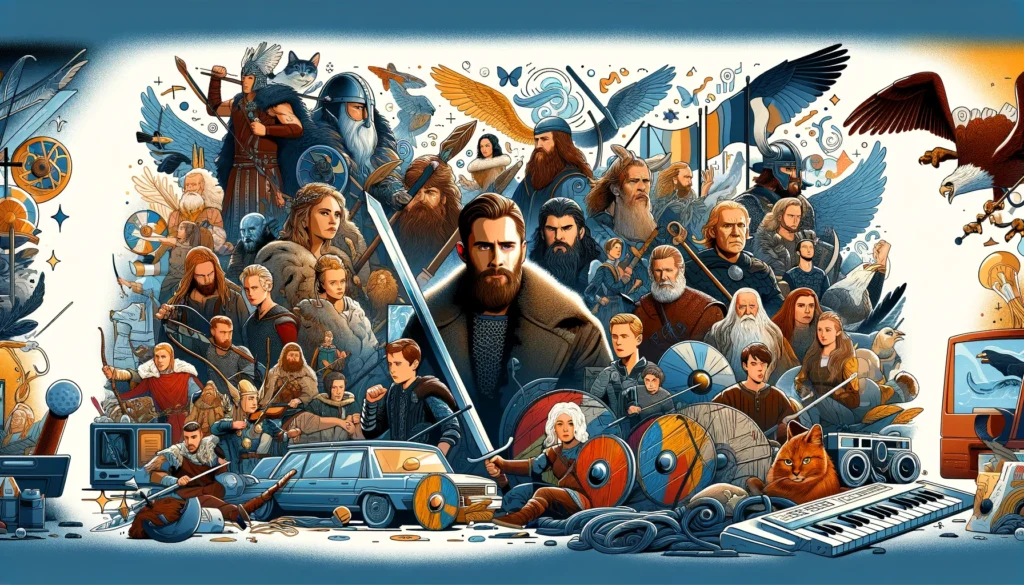
Viking art has significantly influenced popular culture, particularly in modern media like movies, books, and television shows. This cultural infusion highlights the enduring fascination with Viking history and mythology.
Viking Art in Movies and Television
The portrayal of Vikings in movies and TV often includes:
- Costume Design: Inspired by traditional Viking clothing, filmmakers incorporate Norse patterns and symbols into costumes.
- Set Design: Movie and TV sets often feature Viking art-inspired designs, including carvings, runestones, and iconic longships.
Influence on Literature
Viking art and culture have inspired numerous literary works:
- Historical Novels: Books that explore Viking history, often incorporating descriptions of Viking art and lifestyle.
- Fantasy Literature: Many fantasy novels draw on Norse mythology, integrating Viking art symbols and themes.
Viking Art in Video Games
Video games frequently feature Viking art-inspired aesthetics:
- Game Design: From character costumes to the virtual environment, Viking art influences the visual aspects of many games.
- Storytelling: Games often use Norse mythology and Viking history as a backdrop for storytelling.
Music and Viking Imagery
Viking themes have also penetrated the music industry:
- Album Art: Bands, especially those in the metal genre, often use Viking art for album covers and merchandise.
- Music Videos: Incorporate Viking art and themes to create a unique visual experience.
Educational Media
Viking art is used in educational contexts to engage learners:
- Documentaries: Visual elements of Viking art help bring historical documentaries to life.
- Educational Books and Materials: Viking art is used to illustrate and educate about Norse history and culture.
The Impact on Modern Art
Contemporary artists are often inspired by Viking art:
- Modern Artworks: Artists create works that reinterpret Viking motifs and symbolism in a modern context.
- Exhibitions: Art exhibitions sometimes feature Viking-themed pieces, showcasing the influence of Norse culture in the art world.
The Role of Viking Art in Cultural Exchange
Viking art plays a significant role in cultural exchange by:
- Promoting Norse Culture: Helps in spreading awareness and appreciation of Norse heritage.
- Cross-Cultural Influence: The integration of Viking themes in various media shows the cross-cultural appeal of Norse art.
Viking art in popular culture demonstrates the widespread appeal and influence of Norse heritage. Its presence in various forms of media not only entertains but also educates and inspires, keeping the Viking spirit alive in contemporary society.
Interactive Viking Art for Educational Purposes

Interactive Viking art serves as a powerful tool in education, engaging audiences and providing an immersive learning experience about Norse culture and history.
Use in Museums and Exhibitions
Interactive displays in museums enhance the learning experience:
- Touch Screens: Interactive touch screens provide detailed information about Viking artifacts and their historical context.
- Virtual Reality (VR) Experiences: VR technology allows visitors to immerse themselves in a recreated Viking world.
Educational Programs
Schools and educational institutions leverage Viking art for teaching:
- Interactive Workshops: Programs where students can engage in hands-on activities like traditional Viking crafts.
- Educational Games: Games and puzzles based on Viking art and history help in making learning fun and memorable.
Online Learning Resources
The digital space offers extensive resources for learning about Viking art:
- Digital Galleries: Online galleries showcase Viking artifacts, often with interactive features for in-depth exploration.
- Educational Websites and Apps: Dedicated platforms provide interactive learning modules on Viking culture.
Public Events and Festivals
Events and festivals often include educational aspects of Viking art:
- Live Demonstrations: Artisans demonstrate traditional Viking crafting techniques.
- Interactive Exhibits: Attendees can interact with replicas of Viking art and learn about their significance.
Role in Cultural Preservation
Interactive Viking art plays a crucial role in cultural preservation:
- Engaging Young Audiences: Interactive elements attract and engage younger generations, ensuring the transfer of knowledge.
- Promoting Norse Heritage: Through engagement, these programs promote the preservation and appreciation of Norse heritage.
The Impact on Learning
The impact of interactive Viking art in education is profound:
- Enhanced Understanding: Interactive elements help in better understanding the historical and cultural context of Viking art.
- Memorable Learning Experiences: Engaging activities create a lasting impression, making the learning process enjoyable and effective.
Interactive Viking art for educational purposes not only makes learning about Norse culture more engaging but also ensures that this rich heritage continues to inspire and educate future generations. Through these interactive experiences, the legacy of the Vikings is kept alive and accessible to a broad audience.
DIY Viking Wall Art Projects
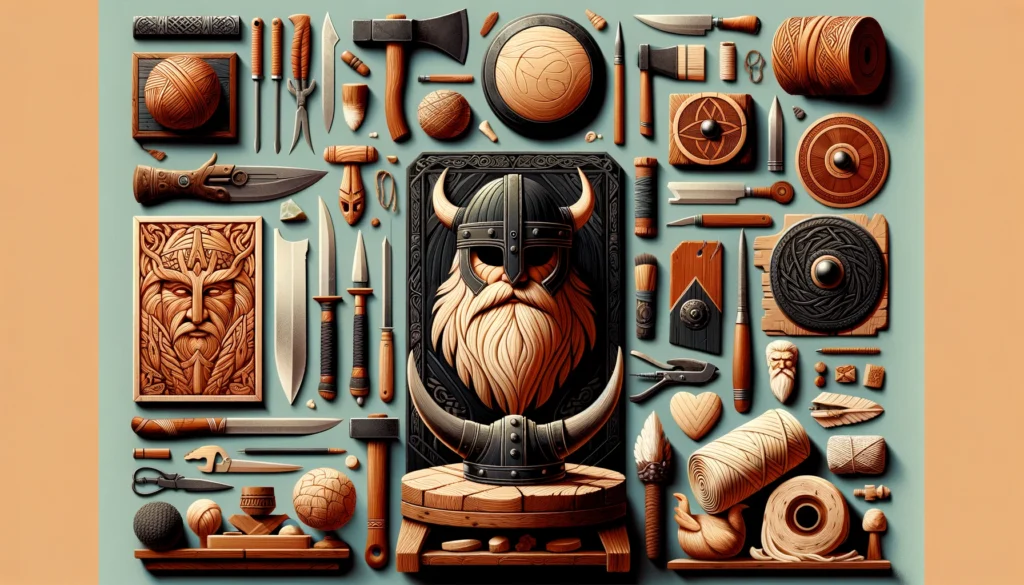
DIY Viking Wall Art Projects offer a creative and personal way to connect with Viking culture. These projects allow individuals to craft their own pieces of Norse-inspired art, using various techniques and materials.
Getting Started with DIY Viking Art
Begin your DIY journey by:
- Researching: Understanding Viking symbols, motifs, and styles to incorporate into your project.
- Gathering Materials: Depending on the project, you may need wood, metal, textiles, paints, and carving tools.
Popular DIY Viking Art Projects
Some popular projects include:
- Carving Rune Stones: Carve or paint runes onto stones or wood pieces for a simple yet historically rich project.
- Creating Viking Shields: Design and decorate a wooden shield with traditional Viking patterns and symbols.
- Viking Textile Work: Use embroidery or fabric painting to create wall hangings with Viking designs.
Step-by-Step Guides
Find or create step-by-step guides to help with your project:
- Online Tutorials: Many websites and video platforms offer tutorials on creating Viking art.
- Workshops: Some communities offer workshops on traditional crafts, including Viking-style artistry.
Tools and Techniques
Familiarize yourself with the tools and techniques used in Viking art:
- Carving Tools: Learn how to safely use carving tools for wood or stone projects.
- Painting Techniques: Understand the basics of painting, including color mixing and brushwork for detailed designs.
Safety Considerations
Safety is paramount in any DIY project:
- Proper Equipment: Use gloves, goggles, and other safety gear as needed.
- Safe Workspace: Ensure your workspace is well-ventilated and organized.
Community and Sharing
Join a community of like-minded individuals:
- Forums and Groups: Online communities can offer advice, inspiration, and support.
- Showcasing Your Work: Share your finished projects online or in local art shows.
The Satisfaction of DIY
Creating your own Viking wall art provides:
- Personal Connection: A deeper connection to the art and culture of the Vikings.
- Creative Expression: An opportunity to express your creativity and personal style.
DIY Viking Wall Art projects are an excellent way for enthusiasts to immerse themselves in Viking culture and express their creativity. With the right tools, materials, and a bit of inspiration, anyone can create a piece of Norse history to proudly display.
Viking Art and Global Influence
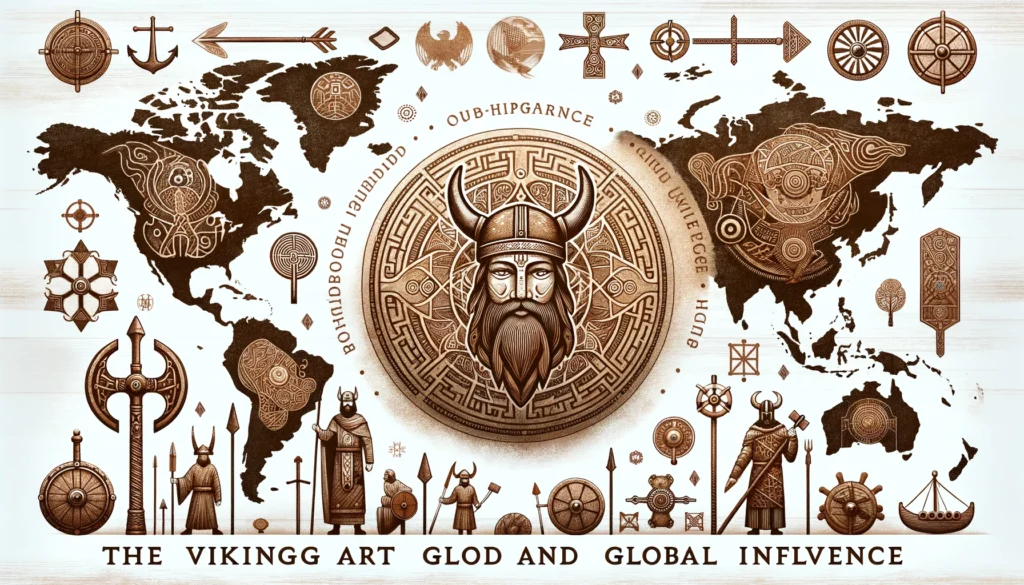
The influence of Viking art extends far beyond its Scandinavian origins, impacting cultures and artistic traditions around the globe. This section explores how Viking art has left its mark across different cultures and continents.
Historical Spread of Viking Art
The Vikings were known for their far-reaching voyages, and with these, they spread their art and culture:
- Trade and Exploration: Through trade routes and explorations, Viking art and motifs were introduced to various regions.
- Cultural Exchanges: Interaction with other cultures led to the incorporation of different artistic elements in Viking art.
Viking Art in Modern Global Culture
Today, Viking art is celebrated worldwide:
- Global Art Exhibitions: Exhibits featuring Viking art and artifacts are held in museums across the world, drawing international audiences.
- Influence on Contemporary Artists: Artists globally are inspired by Viking symbolism and styles, incorporating them into modern artworks.
Viking Art in Educational Curricula
Viking art has found its way into educational systems around the world:
- Art History Courses: Many universities and schools include Norse art in their art history and cultural studies courses.
- Workshops and Seminars: Educational workshops focusing on Viking art and craftsmanship are conducted internationally.
Representation in Media and Entertainment
The global influence of Viking art is evident in media and entertainment:
- Films and TV Shows: International productions often feature Viking art and aesthetics, especially in historical dramas.
- Video Games and Graphic Novels: These mediums frequently draw on Viking art for character designs and settings.
Cross-Cultural Collaborations
Collaborations between artists from different cultures often result in unique blends:
- Artistic Collaborations: Artists from various backgrounds come together to create works that blend Viking art with other cultural elements.
- Cultural Festivals: Festivals around the world celebrate Viking culture, often featuring art and craft workshops.
The Role of Technology in Spreading Viking Art
Technology has played a significant role in the global reach of Viking art:
- Digital Galleries and Online Exhibitions: Virtual tours and online galleries make Viking art accessible worldwide.
- Social Media: Platforms like Instagram and Pinterest allow artists and enthusiasts to share and discover Viking art globally.
Impact on Global Art Trends
Viking art continues to influence global art trends:
- Design and Fashion: Elements of Viking art appear in modern design and fashion, from jewelry to clothing patterns.
- Tattoo Art: Viking symbols and motifs are popular in the world of tattoo art.
Viking art’s global influence is a testament to its universal appeal and enduring legacy. It continues to inspire, educate, and connect people across different cultures and geographies, proving that art knows no boundaries.
Buying Guide for Viking Wall Art
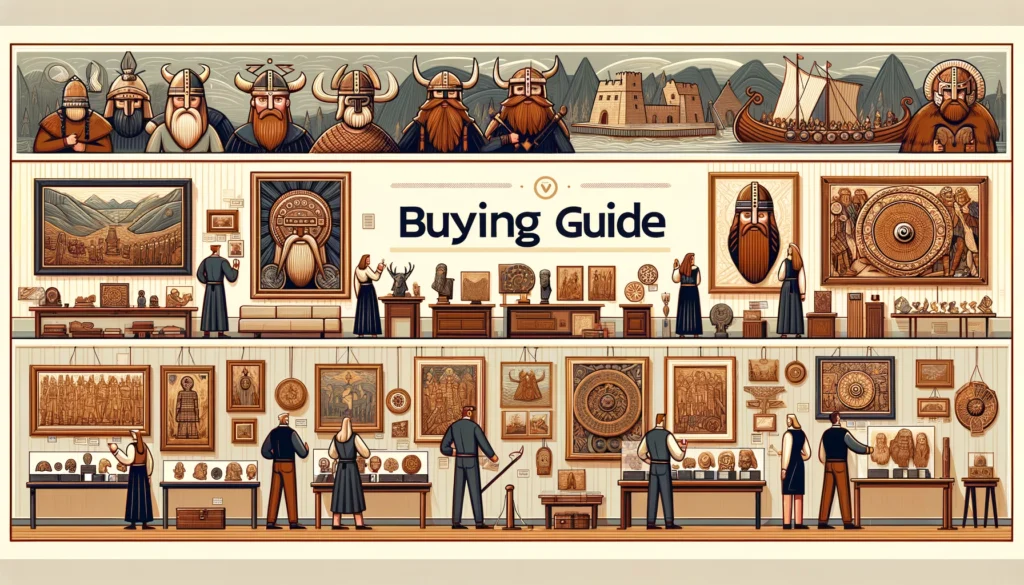
When it comes to purchasing Viking wall art, whether for collection, decoration, or educational purposes, there are several factors to consider to ensure you acquire a piece that is both authentic and suits your preferences.
Determining Authenticity
The authenticity of Viking art is crucial, especially for collectors:
- Provenance: Research the history and origin of the piece. Authentic pieces will often have documented provenance.
- Expert Verification: Consult with experts or historians, especially for high-value items, to verify authenticity.
Assessing Quality and Craftsmanship
The craftsmanship of Viking art can vary significantly:
- Detail and Precision: Examine the intricacies and finish of the art piece.
- Materials Used: Authentic Viking art pieces are made from specific materials like wood, metal, and textiles that align with historical methods.
Understanding the Style and Era
Viking art encompasses various styles and eras:
- Historical Styles: Familiarize yourself with the different historical Viking art styles (e.g., Borre, Jelling, Mammen) to understand what era a piece might belong to.
- Contemporary Interpretations: Modern Viking art can vary in style. Decide if you prefer traditional designs or contemporary interpretations.
Where to Buy Viking Art
There are several places where you can purchase Viking art:
- Specialty Galleries and Shops: These often have a selection of authenticated pieces.
- Online Marketplaces: Websites may offer a range of Viking art, but it’s important to verify sellers and authenticity.
- Art Fairs and Markets: These can be great places to find unique pieces, though the authenticity may vary.
Setting a Budget
Viking art can range in price:
- Set a Realistic Budget: Prices can vary widely based on the art’s age, size, material, and artist.
- Consider Long-Term Value: For investment pieces, consider the potential long-term value of the art.
Legal Considerations
Be aware of legal aspects:
- Cultural Heritage Laws: Some countries have laws about owning and exporting historical artifacts.
- Purchase Documentation: Always obtain and keep any purchase documents, which can be crucial for authentication and resale.
After-Purchase Care
Consider how you’ll care for and display the art:
- Preservation Needs: Some older pieces may require special care or conservation.
- Display: Consider how and where you’ll display the art, keeping in mind factors like lighting and humidity.
Involving Art Advisors
For high-value purchases, consider involving an art advisor:
- Expert Guidance: They can provide valuable advice on authenticity, value, and care.
- Investment Analysis: An advisor can help assess the potential investment value of a piece.
Purchasing Viking wall art is an exciting venture that can add cultural value and aesthetic appeal to your space. By carefully considering these factors, you can make a well-informed decision and enjoy your piece of Viking history.
